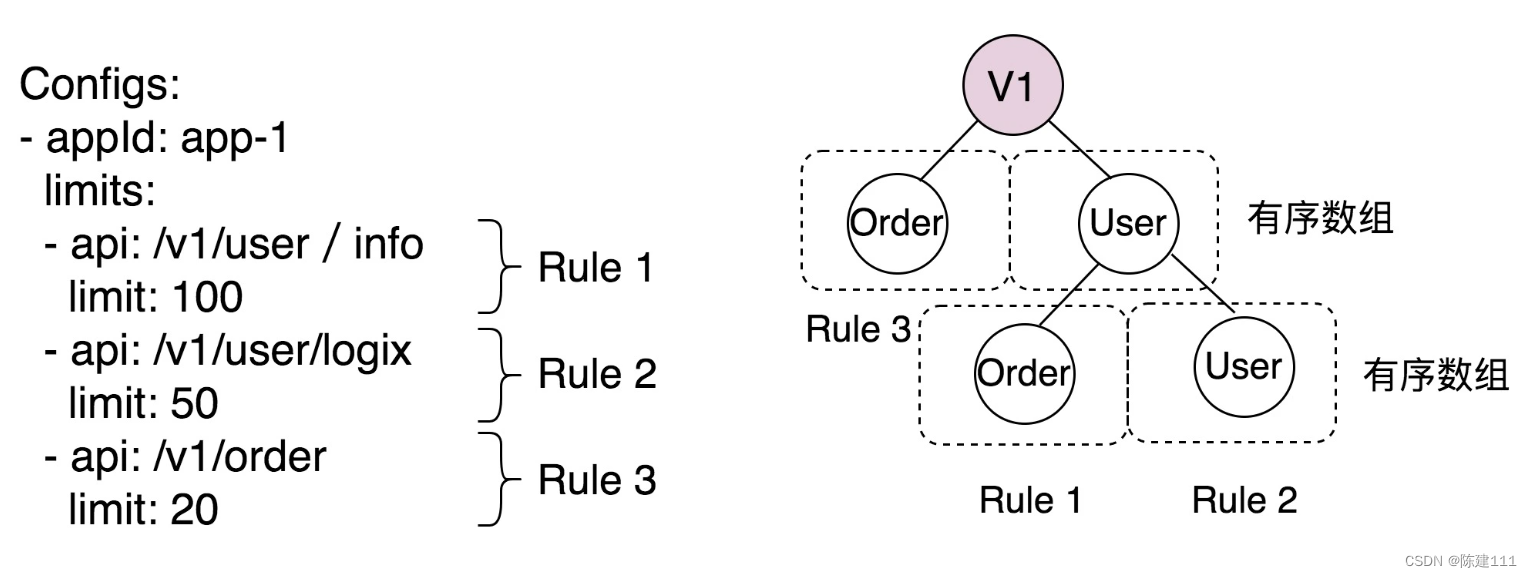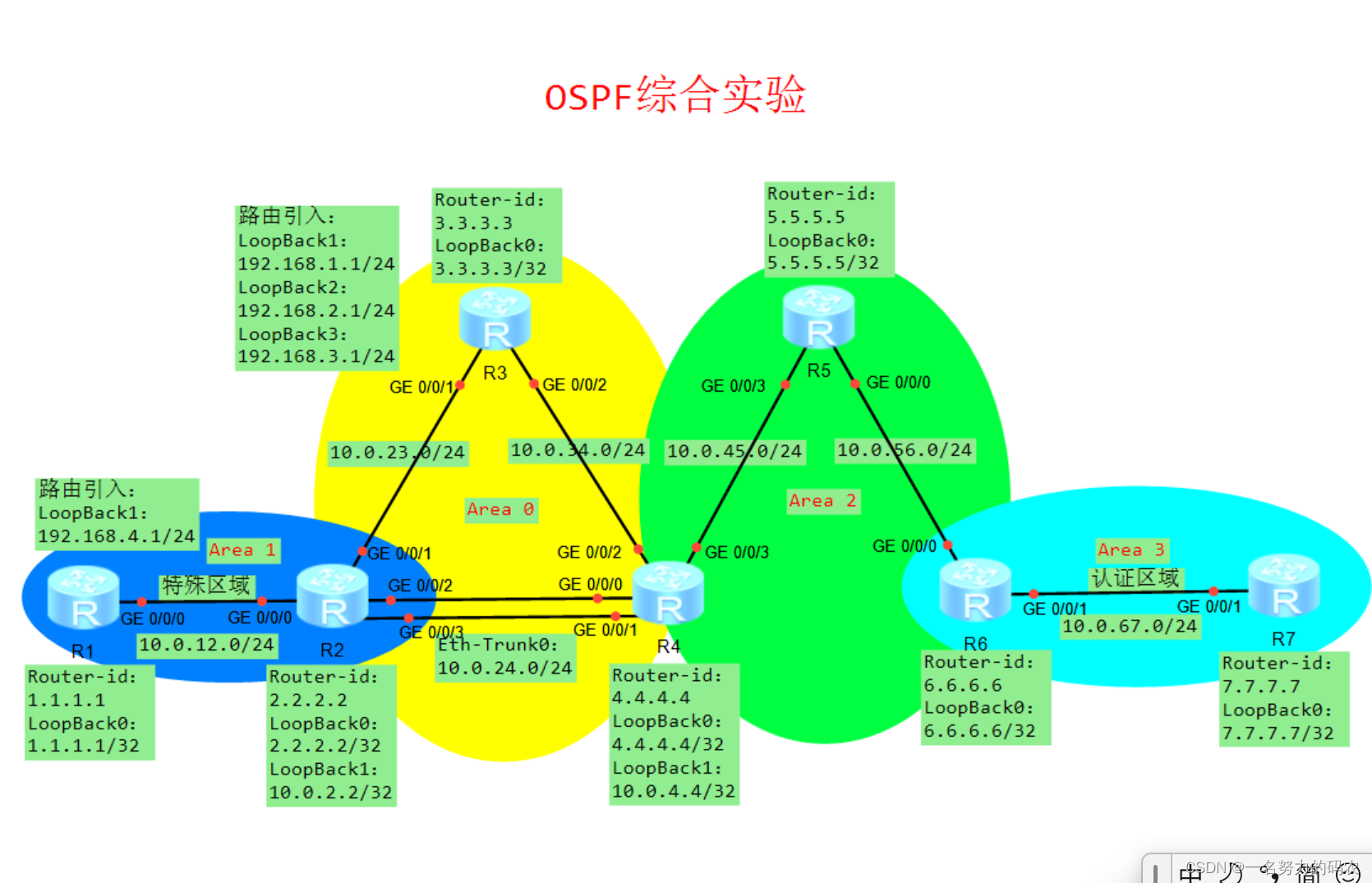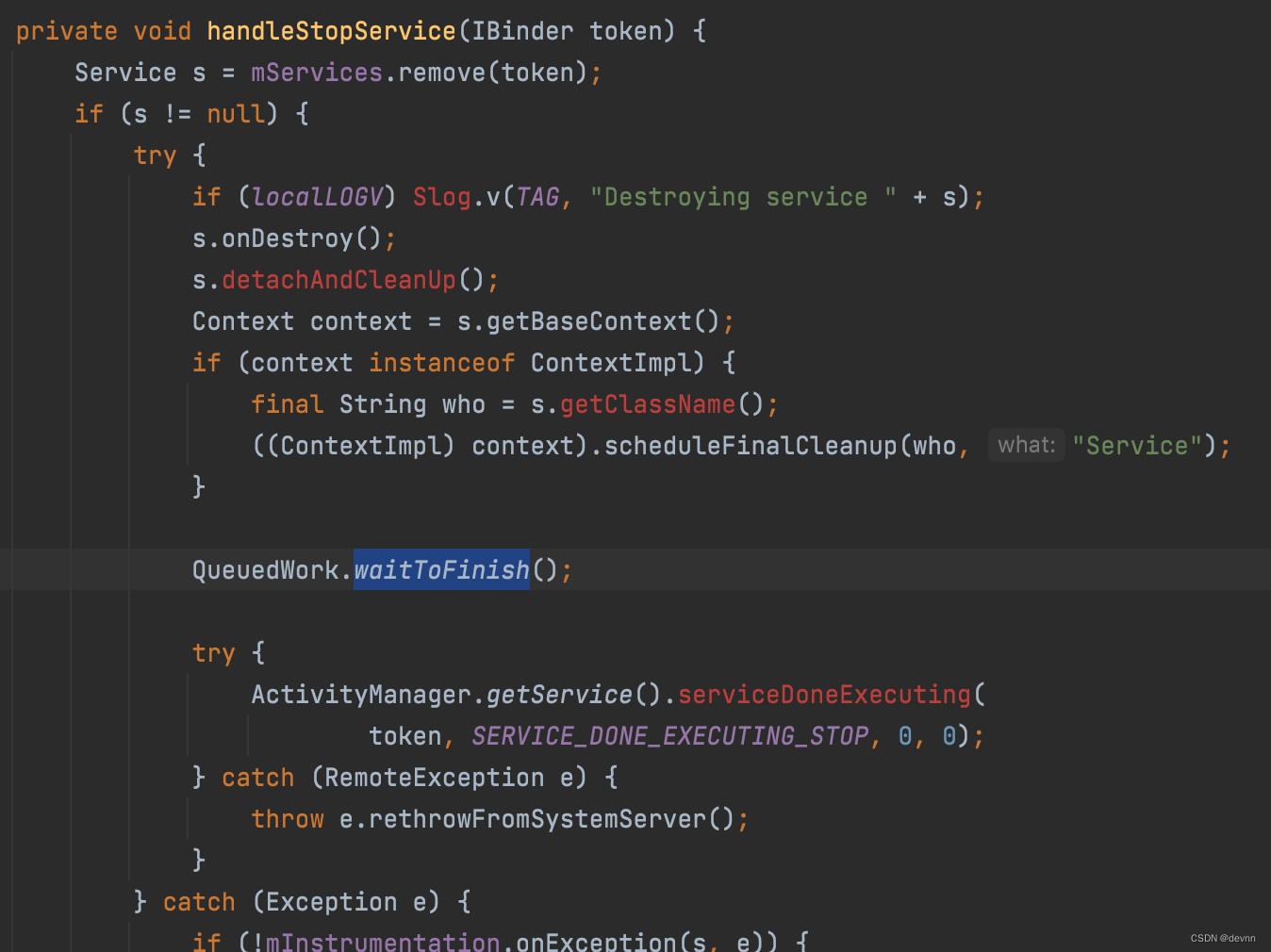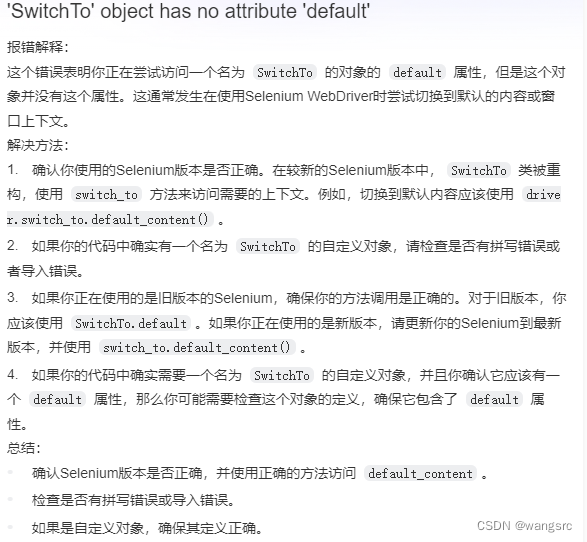An Introduction to American Law

本文是 https://www.coursera.org/programs/career-training-for-nevadans-k7yhc/learn/american-law 这门课的学习笔记。
文章目录
- An Introduction to American Law
- Instructors
- Week 04: Constitutional Law
- Key Constitutional Law Terms
- Supplemental Reading
- Constitutional Law: Part 1
- Constitutional Law: Part 2
- Constitutional Law: Part 3
- Constitutional Law: Part 4
- Constitutional Law Quiz
- 法律英语
- 后记
Instructors
Anita Allen, Henry R. Silverman Professor of Law and Professor of Philosophy, Penn Law, University of Pennsylvania
Shyam Balganesh, Professor of Law, Penn Law, University of Pennsylvania
Stephen Morse, Ferdinand Wakeman Hubbell Professor of Law; Professor of Psychology and Law in Psychiatry; Associate Director, Center for Neuroscience & Society, Penn Law, University of Pennsylvania
Theodore Ruger, Dean and Bernard G. Segal Professor of Law, Penn Law, University of Pennsylvania
Tess Wilkinson-Ryan, Assistant Professor of Law and Psychology, Penn Law, University of Pennsylvania
Tobias Barrington Wolff, Professor of Law, Penn Law, University of Pennsylvania
Week 04: Constitutional Law
The study of constitutional law is among the most exciting parts of the law because it provides for the structure and functioning of the U.S. government. In this module, Dean Ruger will address the document itself, how it has been applied over time, the history of the document, and what makes it unique. The structure of the U.S. government as a government of limited, separated powers will be explored along with the important individual rights the Constitution provides and how the U.S. Constitution compares to others around the world.
Key Constitutional Law Terms
Constitution
The most fundamental law of a country or state (http://www.law.cornell.edu/wex/constitution). The Constitution of the United States of America is the supreme law of the United States. Empowered with the sovereign authority of the people by the framers and the consent of the legislatures of the states, it is the source of all government powers, and also provides important limitations on the government that protect the fundamental rights of United States citizens. (http://www.whitehouse.gov/our-government/the-constitution)
Constitutional Law
The broad topic of constitutional law that deals with the interpretation and implementation of the United States Constitution.
Key Terms:
Articles of Confederation
The first constitution of the United States. For more information, explore this website: http://www.loc.gov/rr/program/bib/ourdocs/articles.html.
Bill of Rights
The first ten Amendments to the Constitution, which set out individual rights and liberties (http://www.law.cornell.edu/wex/bill_of_rights).
commerce power
Congress has the power to regulate the channels and instrumentalities of interstate commerce. Channels refers to the highways, waterways, and air traffic of the country. Instrumentalities refers to cars, trucks, ships, and airplanes. Congress also has power to regulate activities that have a substantial effect on interstate commerce http://www.law.cornell.edu/wex/commerce_power). The Commerce Clause refers to Article 1, Section 8, Clause 3 of the U.S. Constitution, which gives Congress the power “to regulate commerce with foreign nations, and among the several states, and with the Indian tribes.” For more, click here: http://www.law.cornell.edu/wex/Commerce_clause
Due Process
Phrase found in both the Fifth and Fourteenth Amendments, that no one shall “be deprived of life, liberty, or property without due process of law.” These words have as their central promise an assurance that all levels of American government must operate within the law and provide fair procedures. For more, click here: http://www.law.cornell.edu/wex/Due_Process
Equal Protection
The Equal Protection Clause of the 14th Amendment of the U.S. Constitution prohibits states from denying any person within its jurisdiction the equal protection of the laws. In other words, the laws of a state must treat an individual in the same manner as others in similar conditions and circumstances. For more, click here: http://www.law.cornell.edu/wex/equal_protection
executive power
Article II of the Constitution outlines the duties of the Executive Branch, which is headed by the President. For more, click here: http://www.law.cornell.edu/wex/executive_power
Framers of the Constitution
Delegates hailing from all the original states except Rhode Island gathered in the Pennsylvania State House in 1787 to participate in the Constitutional Convention. Many of the delegates had fought in the American Revolution and about three-fourths had served in Congress. The average age was 42. (http://constitutioncenter.org/learn/educational-resources/founding-fathers/)
incorporation
Though the Bill of Rights originally only applied to the federal government, through this legal doctrine, portions of the Bill of Rights are applied to the states through the Due Process Clause of the Fourteenth Amendment. (http://www.law.cornell.edu/wex/incorporation_of_the_bill_of_rights)
judicial review
The idea that the actions of the executive and legislative branches of government are subject to review and possible invalidation by the judicial branch. Judicial review allows the Supreme Court to take an active role in ensuring that the other branches of government abide by the constitution. (http://www.law.cornell.edu/wex/judicial_review)
political party
Group of persons organized to acquire and exercise political power. Formal political parties originated in their modern form in Europe and the U.S. in the 19th century. Whereas mass-based parties appeal for support to the whole electorate, cadre parties aim at attracting only an active elite; most parties have features of both types. All parties develop a political program that defines their ideology and sets out the agenda they would pursue should they win elective office or gain power through extraparliamentary means. Most countries have single-party, two-party, or multiparty systems (see party system). In the U.S., party candidates are usually selected through primary elections at the state level. (http://www.merriam-webster.com/dictionary/political party)
separation of powers
Political doctrine of constitutional law under which the three branches of government (executive, legislative, and judicial) are kept separate to prevent abuse of power. Also known as the system of checks and balances, each branch is given certain powers so as to check and balance the other branches. (http://www.law.cornell.edu/wex/separation_of_powers)
Taxing Power
Congress has power under Article I, Section 8 to lay and collect taxes, duties, imposts and excises, to pay the debts and provide for the common defense and general welfare. Under the 16th Amendment, Congress can collect taxes on incomes that are derived from any source. As long as Congress has the power to regulate a particular activity that it wishes to tax, it can use the tax as a regulating device rather than in order to raise revenue. (http://www.law.cornell.edu/wex/taxing_power)
Supplemental Reading
- The U.S. Constitution
- The Constitution from President Obama White House Archives
- “The Constitution of the United States: A History”
- “[Our Constitution](http://www.annenbergclassroom.org/Files/Documents/Books/Our Constitution/COMPLETED_Our Constitution.pdf)”
- Excerpt from Westlaw’s Black Letter Law Outline: Constitutional Law
Constitutional Law: Part 1
[MUSIC] Welcome to this segment of Introduction
to American Law, on the US Constitution. I’m standing here in the reading room
of Penn Law School’s library just a few miles from where the constitution
was framed over two centuries ago. In the city of Philadelphia. My name is Theodore Ruger. I’m a professor of constitutional law and health law at the University
of Pennsylvania Law School. And my segment today will focus
on various features of the US constitution’s distinctiveness. I’ll begin by asking
the fundamental question, what is the American Constitution and
American constitutional law. And focus specifically on the distinct
place of American Constitution and American constitutional
development in the world. Scholars and visitors to the US have long
recognized the US Constitution as unique. Going back almost 200 years, Alexis de Tocqueville,
on his visit to the United States, remarked specifically about America’s
unique constitutional culture. De Tocqueville observed, the obligation
to base decisions on the Constitution as opposed to the law was peculiar to the
American judge, at the time he visited. What he meant in this
is that many countries, of course,
had common law regimes and statutes. But, when De Tocqueville visited the US the US was unique in it’s
written Constitution.

Much later, in marking the Bicentennial
of the US Constitution in 1989, Time Magazine released a special issue in which it called our Constitution
a gift to all nations. And proclaimed proudly that 160 of
the 170 nations then in existence. That modeled their
constitution upon our own.
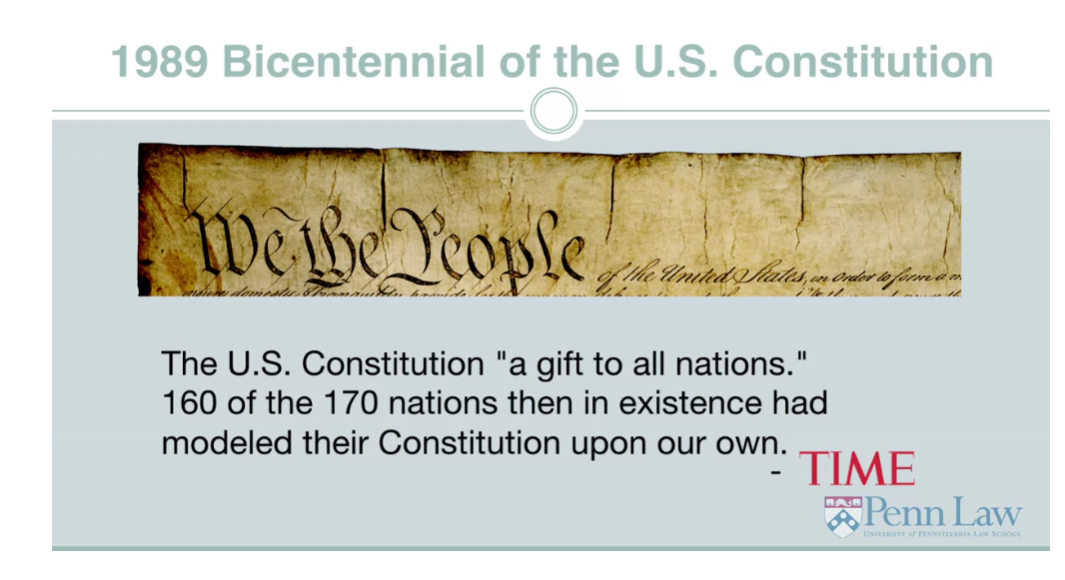
Around the same time,
Guido Calabresi leading scholar, dean of, former dean of Yale Law School and
a judge, described the other countries in the world
as our quote constitutional offspring.

I’ll explore these themes in this segment. And while it is true that
the US Constitution is distinctive. What we’ll see is that if,
if other countries are our constitutional offspring, as Judge Calabresi has said,
they’re an offspring that have take a very different path in some key ways
then the US constitutional development. In this segment I’ll explore
four different major themes. First, I want to talk about the basic
text of the Constitution and the long history of interpretation that
has taken place in American legal culture, which itself is virtually
unique in the world and forms a unique and distinctive aspect
of American constitutionalism. Then I’ll look at a few diff, different kind of broad clusters of
constitutional rights and structures. First, the manner in which our
constitution divides government and it divides it twice. Both vertically between the federal and state governments and then horizontally
across the federal government into the different branches of the legislature,
the executive branch and the judiciary. And I’ll explore some current
debates that resound even today about the proper allocation of
those different governmental structures. I’ll then turn to what many of us
think about when we think about the constitution, namely the individual
rights that we hold dear, and that government and
the courts struggle to mediate and strike the proper balance in, in applying
things like freedom of religion. The right to be free of
race discrimination. The right to bare arms,
the right to assemble as we choose. All of these form a core part of
the american constitutional tradition.
And although we don’t have time in this
segment to explore each one in great detail, I’ll explore some general themes
that I think cluster around the general area of independent individual rights
protection in the American tradition. Finally, I’ll conclude by talking about the US Constitution’s distinct
influence in the world. And the manner of which many other
countries that have recently adopted written constitutions somewhat along the
US model have chosen different paths and gone in different directions then,
then the US has in ways that I, then in turn shines a light on what’s truly
unique about the American experience.
Now I’ll turn to the first
substantive section of this segment, which deals with the Constitution’s
basic text, history, and interpretation. Some general themes that
guide us as we think about the Constitution in specific
applications to individual rights areas.

The first most basic question
we might think about. And one, it’s one that people
have been struggling about for the entire life of the US Constitution,
is what is the US Constitution. Where is it? Where do we find it? Now, at first glance we might
think that’s a very simple answer. Of course, we have a written constitution. It has a text. And we might say, well,
that’s it and that’s all there is. As I’ll assert in the next few minutes, I
think that is dramatically wrong, both in, as a descriptive matter of the way
the Constitution has been interpreted and as a normative matter of how
we ought to interpret it.
But, let’s talk about the text and
the history a bit to start out with. I hold in my hand here the full text of
the constitution in this little booklet. It’s a booklet I picked up at
the Supreme Court many years ago. The Constitution of
the United States of America. As you’ll see this is a slim document and
as I’ll, I’ll describe in, in detail in a few minutes,
this is the world’s shortest constitution. And the, the brevity of our constitution
itself is it self important, and it creates a kind of
interpretative imperative. These words in this little
document are often vague and unspecified, and
they don’t interpret themselves. And much of what the american
constitution tradition has been over the past many centuries,
has been an effort to translate and give content to these very sparse and
undefined words.
So we might say,
where is the Constitution? Is it in the text? I would say, yes it is. But it’s not fully embodied
in this tiny little, little booklet that I hold in my hand. Where else might we look then? We do need to think about the text and
the text is one thing that endures. But as we look at the his,
history of constitutional development in the United States,
we see the, the role of time. And here I mean the several centuries that
this constitutional text has been with us, is important, and is foundation in
how we think about the document. The document stays with us, but
our we as a people change over time. And that inflects and
affects the way we interpret the document. And we can see real life
examples in the Supreme Court of the way the court itself changes in
its own interaction with the document.
We also have a crucial role in,
in American history in the institutions that shape and
contest constitutional meaning. When we talk about those institutions, obviously the primary institution we talk
about is the United States Supreme Court, a group of, these days, nine unelected
judges who sit in Washington DC. Originally for much of the nation’s
history the court had fewer than nine. Justices but we, we,
when we talk about constitutional meaning we need to look beyond the court and think
about all of the other institutions in our civic society that that
participate in interpretation.
Legislatures, indeed in the early
days it was primarily legislatures. and, non judicial actors that participated
in constitutional interpretation. The executive branch, certainly at the
federal level as well as the state level is a focal point where the vast majority
of decisions about constitutional rules are made much more so than the very few
cases that reach into the supreme court. And then much more broadly, and in ways
that constitutional scholarship has started to take account of
within the last decade or two, these words at the bottom come
right from the constitution itself, We the People, the American people
in all of our kind of diverse and often contested debates over
constitutional meaning. We play a leading role in
interpreting the Constitution and in updating its meaning through the
generations over the past two centuries.
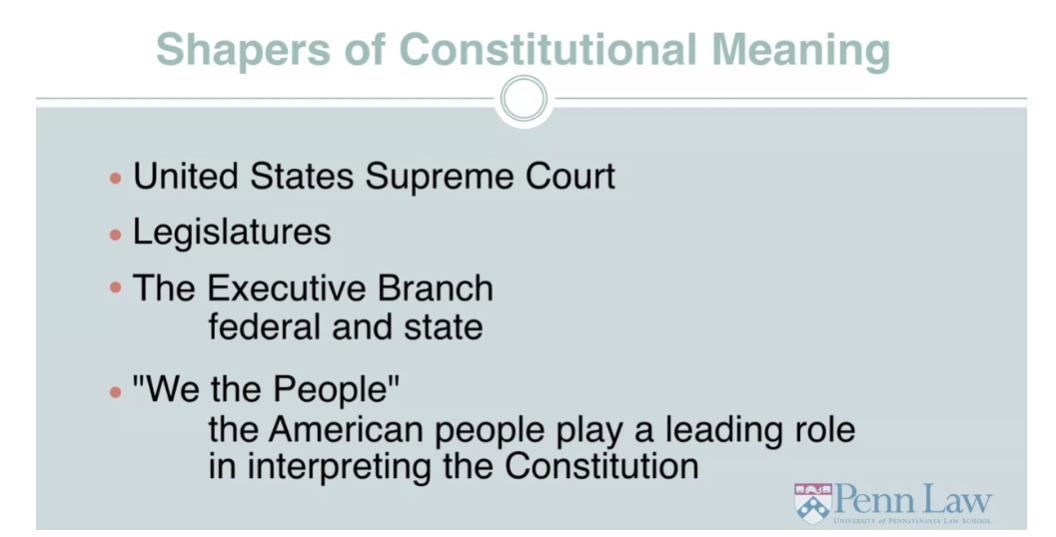
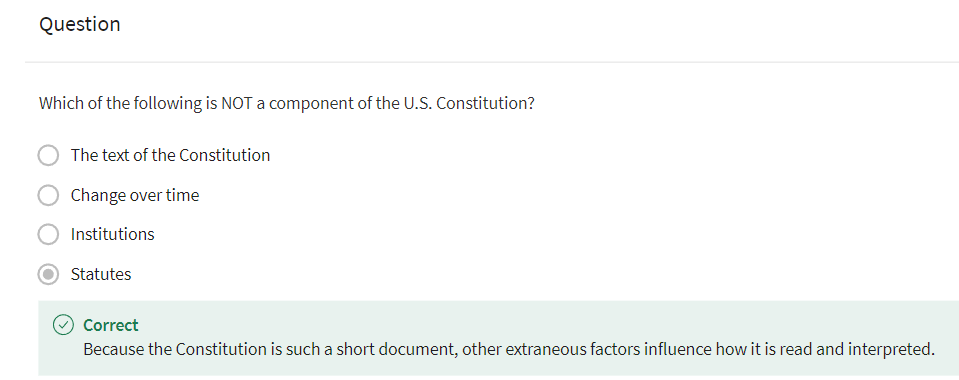
Let me say a bit more about the text and
history by returning to where these all started just
a few miles from where I stand here today. In the old city of Philadelphia here in
this building called Independence Hall. It’s important to note, and
then very important for the American constitutional story
that the framers of this country, and of the Constitution, met here twice,
separated by more than a decade. They met in 1776 while still part of the British Empire to frame
a document that’s central to our. Political tradition called
the Declaration of Independence, declaring that this nation would,
would, would form free of Britain and and
chart a course as a new nation. And we celebrate that day, July 4th, 1776. One day we don’t celebrate is July 12th, 1776
Because after the Declaration of
Independence, which we all remember, the framers sat around, and they drafted
a constitution for this new nation. It’s call, it was called
the Articles of Confederation. And it was, that was draft was issued and initially approved by an initial
vote on July 12th, 1776. Now today,
that is not a date we celebrate in United States history because
the original constitution. Was, in many senses a failure. And so the framers had to come back
again in 1787 to essentially do version 2.0 of the constitution. And this is important for the way we
think about the constitution, because we, our constitution that endures with
us today then, was born out of a failed experiment in constitutionalism
called the Articles of Confederation. What was wrong with the articles? They created a government
that was too weak. There was no central executive,
there was insufficient power to tax and on, at the national level there
was insufficient ability to reign in the self interested and
counter productive behaviors of state governments that would do things
like enact their own internal tariffs. Engage in their own foreign policy. and, and things of that sort. Simply put the articles of confederation
was no way to run a serious nation state.
And when the so the framers when they
gathered in 1787 were trying to do two. Things which are, were in tension then and
remain in tension and create some of our greatest
constitutional debates. They were trying to structure
a government that was restrained and protected individual liberty. And the, these,
those values remain important and central to,
to our constitutional tradition. But at the same time, keeping in mind the failures of
the Articles of the Confederation. They were trying to create a government
that worked, and that had the strength and efficiency and capability to address
national problems on a national scope.
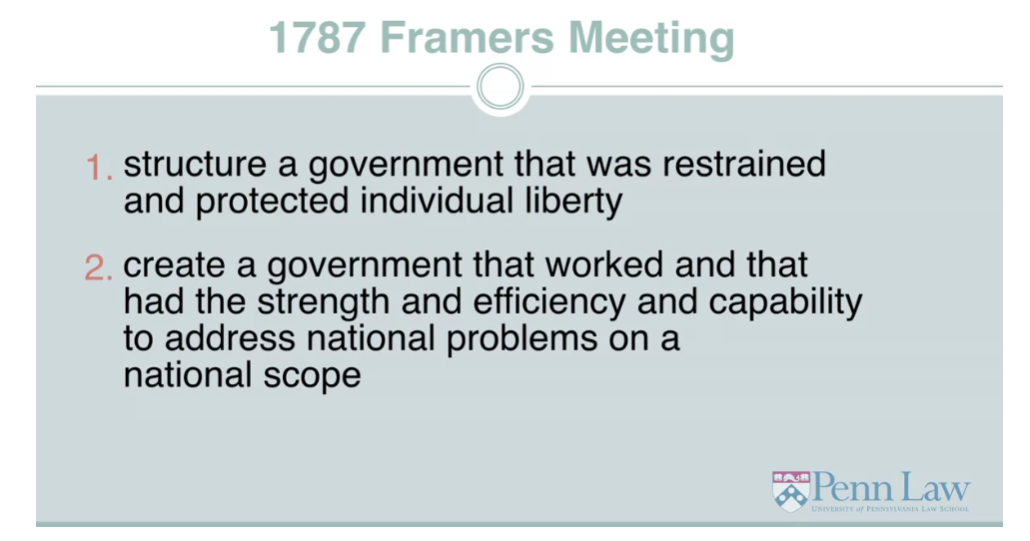
The important compromise of the Constitution is that it balances a limited government, that protects individual liberty, with a government that is strong enough to address national problems. The Articles of Confederation failed in great part because it lacked this second element.
So, it’s these conflicting impulses
that we see today, even in debates say, over the new Affordable Care Act
passed a few years ago. Which attempts to address national
problems of health care on a national scale. And which has generated constitutional
debate over individual liberties. Even as it tries to address
pressing health problems. These debates don’t go away. They are essential to our
constitutional culture. And they, in a sense, date all the way
back to these beginning principles where the Framers tried to do,
to do two very different things. The most important Founding Father, James Madison, was aware of this internal
tension and expressed in, in writings. In important writings called
The Federalist Papers. So Madison said in Federalist fifty one. Quote in framing a government which is
to be administered by men over men, the great difficulty lies in this. You must first enable the government
to control the government, and in the next place,
oblige it to control itself.
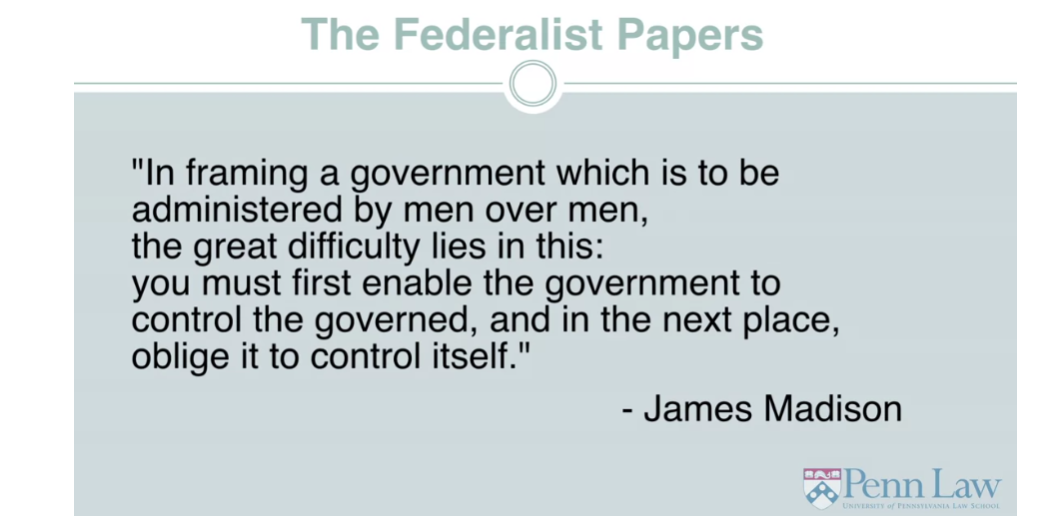
Consider Madison’s words in
the context of our present, present debates today which
bear the same internal tension. First, we want a government that
is strong enough robust enough to control the governed, governed and, and effectuate legitimate solutions to
the problems we face as a nation. But we also want a governmental structure
and we want a constitution that controls the government itself and
protects individual liberty, and structures governmental
decision making in a way that. Promotes the optimal
functioning of our democracy. These are the things that the men who met
here over two centuries ago struggled with and attempted to strike a balance with. And it’s the very same balance that
in our own constitutional debates and interpretation we attempt to strike today.
Let me now turn to some specific
choices the framers made in 1787 about the document itself that still have
major interpretation implications for the way we think about the constitution. So what is unique about the actual
text of the constitution? The first thing that’s unique, and that we take for granted a bit, most
countries in the world have now, finally. Followed our lead on but was very unique in 1787 was the very
fact of a written constitution. Lots of countries including perhaps
most notably Great Britain, have long constitutional traditions. But until very recently those traditions
and the constitutional culture and rules of those societies. Were not captured and collected and
written in a single short document. Another unique feature about
the US Constitution is not just that it was written but how few words
the framers used in their writing of it. The Constitution comes in
at just over 4,000 words, which is remarkably short by comparison
to other constitutions in the world. Compared to the longest constitutions
we see both around the world and in our own state governments. The US Constitution is remarkably short,
again, at just over 4,000 words. By comparison, the Constitution of the
nation of India in it’s English language version is almost 120,000 words long and even that isn’t the longest constitution
that we have in this library. That would be the Constitution
of our own state of Alabama. Which clocks in at over 300,000 words. By this standard of course, then to use a few thousand words as
the framers of the US Constitution did to set up an entire government
structure is incredibly sparse. And that very brevity,
I has clear interpretive interpretations. With so few words there was no time for
definitions clauses, or lengthy explanations of the key
constitutional provisions. Instead our core constitutional
guarantees, and our core structural provisions that structure
government, are laid out in clear, but very sparse terms, which indeed I would
invite subsequent generations to. Interpret and, and
put substance in to those sparse phrases. This is something I’ll talk
more about in this segment.
Not only is the US Constitution
extremely short, it’s also extremely difficult to change. It is among the World’s Constitutions,
the hardest to amend the text. The provisions for
amendment are set forth in a very short provision of the Constitution called
Article V and the most important point is they require extreme super majority
approval by the US states. By super majority I
mean far more than 50%. Indeed three quarters of
the individual states. Need to consent in order for any amendment to be made to
the text of the Constitution. What this means is the text is
extremely difficult to change. The difficulty in amending
the Constitution carries with it extreme interpretive implications. Because the text is so hard to change in
order to update constitutional meaning. With a text that is largely set in stone. The interpreters of the Constitution
led by the Supreme Court, occasionally must revise or update their
understandings of constitutional meaning. This is something we see over time, over
the generations at the Supreme Court, and it’s a central part of out
constitutional culture, that the text itself stays the same. While the legal interpretation
of that text changes over time.
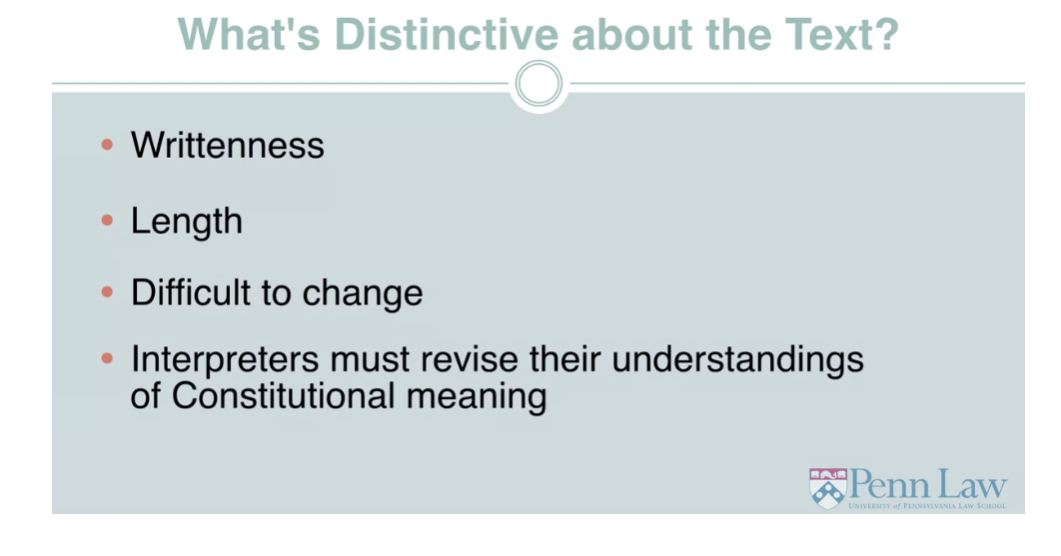
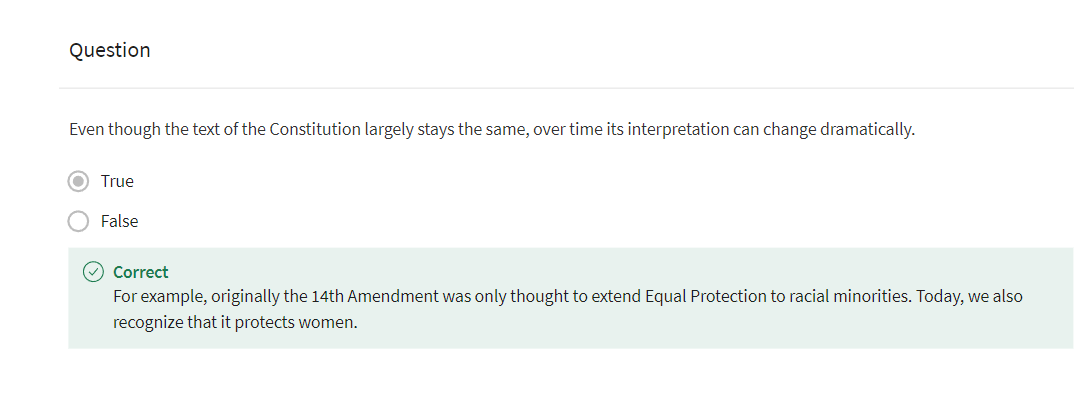
Relatedly the US constitution is
the oldest continuously operating constitution in the world. As I alluded to before and
will return to at the end of this segment. Written constitutionalism backed
back a strong supreme court, is becoming the world’s norm. But for most countries it’s
a phenomenon that has happened only in the past century. The US with a constitutional tradition
stretching back over two centuries has a much longer process of institutional
development than other countries, which itself is a key feature of
our constitutional culture and it affects interpretation
even to the present day. All of these variables that
I’ve been talking about. The writtenness of the Constitution, its
extreme brevity, its age, the difficulty in changing the Constitution, combine with
yet another feature about any kind of written language, which is
the inherent ambiguity of language. And this is a short a Constitution,
in the United States, which contains. Some phrases which are very vague and
don’t come with definitions clauses, and I’ll show you some examples. Some parts of the Constitution are written
in language that is crystal clear, even today. And generally, most readers of the English
language would agree in what it means. Many other parts of the Constitution,
including some of the very most important Parts, are written in language
that was extremely vague then and remains Extremely vague and
compels subsequent interpretation. So for instance the Constitution contains
a very clear requirement about the age of the President. It says, no person shall be
eligible to be President who shall not have attained
the age of 35 years. That’s clear,
it was clear when it was written. And it would be clear today where
any controversy over that to occur. But consider another phrase also
from article two which says, the executive Power should
be vested in President. This is one of the most crucial
foundations of the modern bureaucratic state. This power, the executive power,
on which our entire administration is founded with almost a million employees
virtually everything, everything we think of as the federal executive branch
its authority rests on this clause. Yet the basic phrase here,
the key operative phrase, executive power, is not defined
anywhere in the Constitution. In order to give meaning to that,
what judges and other participants in constitutional debates have had to do over
the past 200 years is contest, debate, and fill in their own interpretation
of what executive power means.
Likewise in the key provisions that
protect our individual rights, some of the most important phrases
are inherently vague and ambiguous. The eighth amendment
prohibits excessive bail. What does excessive mean? It prohibits cruel and
unusual punishments.
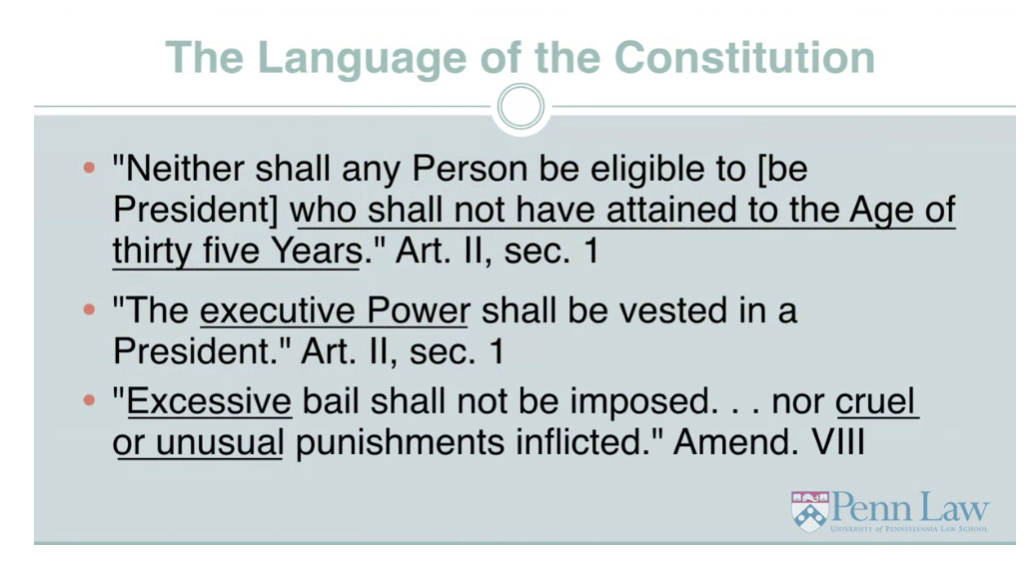
What’s cruel to one person may
not be cruel to somebody else. These are clauses that come
without definitions and without explicit user instructions,
and this is important and this was intentional by James Madison and
the other framers. They did not want a document that
would be fixed in time with explicit. User code, instead,
they envisioned a document where each generation would supply its own
definitions for these grand, but yet inherently vague provisions
in the Constitution.
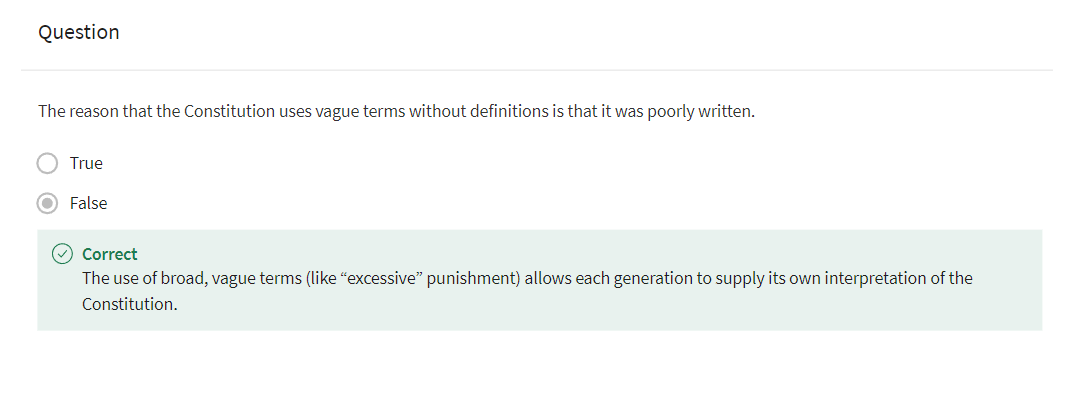
So, how has, how have subsequent interpreters
given meaning to these clauses? And here I bring in a concept
I mentioned a few minutes ago. Namely the notion of institutions and institutional development in
the American Constitutional traditional. We have in our constitutional order
a predominant institution for, for giving meaning to the Constitution. it, we, it’s called the US Supreme Court. And although it wasn’t perhaps
envisioned as such by the framers, very early on in America’s constitutional
development the Supreme Court became the leader institution that gave meaning
to the vague phrases of the constitution. Historically I want to mention
Chief Justice John Marshall. The first great chief justice
of the US Supreme Court, who served for
the better part of the early 19th century. Marshall and his colleagues on Supreme
Court in this era where the ones who began giving the Supreme Court
the prestige that it enjoys today as the leading interpreter
of the Constitution in the US. And Marshall had a very specific vision
for interpreting the constitution. He said in the leading early case
of McCulloch versus Maryland. We must never forget it is
a Constitution we are expounding.
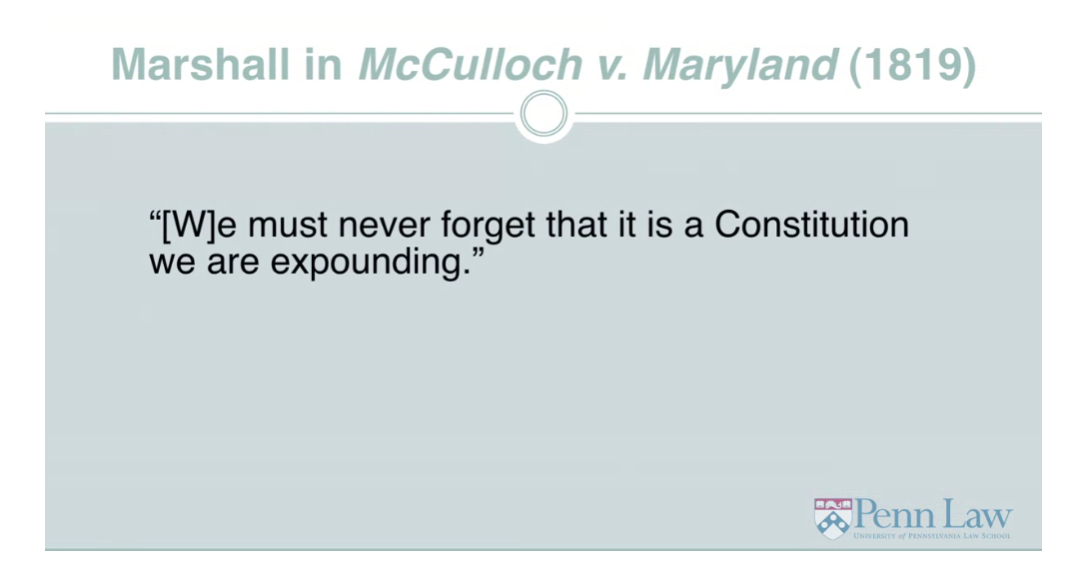
Now what does that mean? He was distinguishing constitutional
interpretation from the interpretation of many other sorts of legal documents. Ordinary consumer contract
ordinary statutes and regulations, wills and
trusts, the ordinary stuff. Of law that judges and
other people deal with on a daily basis. The Constitution in Marshall’s
vision was something different, and it was something that was
intended to endure for much longer. Recall what I said about the extreme
brevity of the Constitution. And the fact that it doesn’t
come with definitions clauses. For Marshall, as for many people who have
followed him, what this means is that judge and other interpreters of
The Constitution over time need to supply their own interpretive effort and
interpretive analysis to these clauses.
Moreover although The Constitutions text remains fixed it’s
interpretation does not. And here we see Marshall arguing
that it would be unwise to provide immutable rules which would lock
constitutional meaning in place. Instead Marshall and
many who have followed him argue for more evolving constitutional culture.
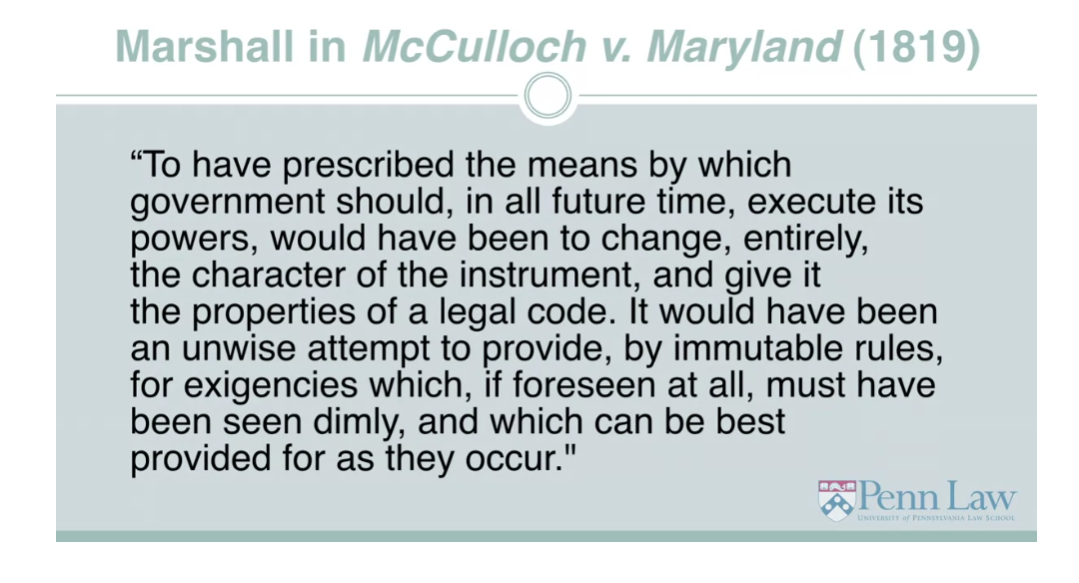
So given the necessity of
subsequent interpretation in our constitutional tradition,
who does the interpreting? Which institutions, which people? The central point is that interpretation
is diffused, pluralistic, and multi-faceted in the US
constitutional tradition. Yes, the Supreme Court has come to be the
leading constitutional interpreter, but by no means is it the only key institution
infusing the constitution with meaning. In the earliest days of the american
republic, the supreme court was largely on the sidelines, instead,
the most heated debates took place in the halls of congress,
in the chambers of state legislatures, and in the public square itself,
the public and the media of the 19th century being explicitly and intently
involved in constitutional interpretation.
So to today, although the US supreme court
has ascended to a predominant place in American constitutional interpretation, by
no means is it the exclusive interpreter. And on some issues, it is not the most important
interpreter of constitutional meaning. What has happened over the past 200
years through the rise of what we call strong form judicial review,
is that the court has attained a pre, predominance in constitutional
interpretation to agree, to a degree that the framers
probably didn’t foresee. And this started to happen early on and indeed John Marshall, once again,
was a key architect of this strategy.

In a famous case in 1803 called
Marbury versus Madison Marshall for the first time asserted the proposition
that it was the Supreme Court. Who was tasked with giving
meaning to the Constitution. Marshall said it is,
it is emphatically the province and the duty of the judicial
department to say what the law is.
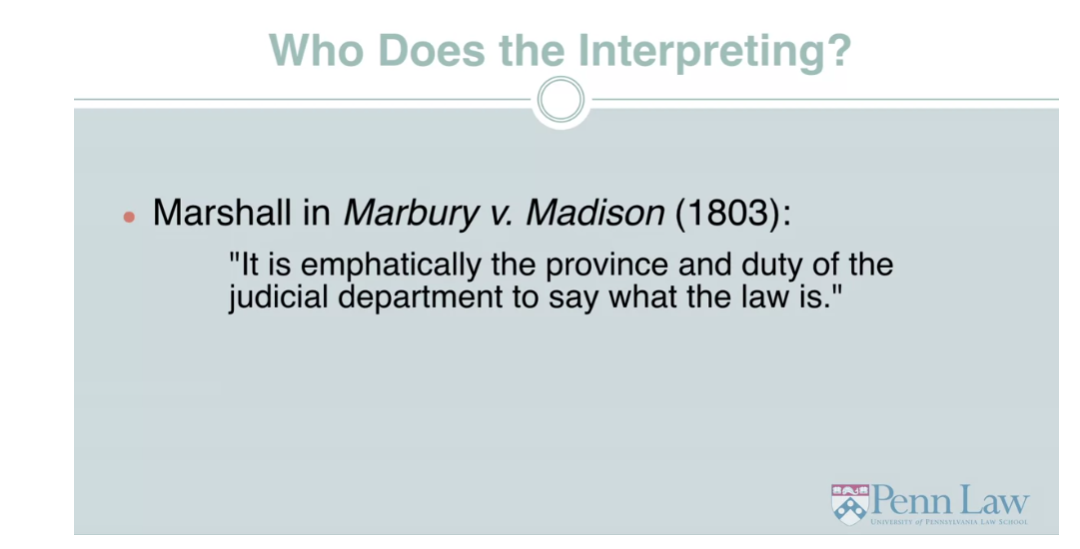
I’ve spoken about the institutions that
give the Constitution meaning to return to one last point that I
alluded to minutes ago. Let me speak about the role
of two centuries of time and historical development in creating
the constitutional culture we have today. Here I would focus on three
separate Supreme Court cases, separated by almost two centuries. The first of these was the case
of Worcester versus Georgia. This case, arising in 1832. Involved a review of the state
of Georgia’s forced expulsion of the Cherokee Indian tribe. Georgia had enacted
policies in taking steps to oust most Cherokees from
the borders of their state. And this was in violation
the Supreme Court held of various laws and treaties of the United States. Georgia was acting unlawfully in
doing this vis-a-vis the Cherokees. What happened in the aftermath of that
decision was telling about the weakness of the Supreme Court in this prior century. As history tells us
President Andrew Jackson allegedly said, John Marshall has made his decision,
now let him go enforce it. And, of course the justices of the court
had no means of enforcing this. And what happened is the sad story that
the Cherokee tribe was indeed ousted from Georgia despite the fact that they had
won a legal victory in the Supreme Court. It was an empty victory because the other
institutions in American life, which would have had power to enforce that decision
against Georgia stood on the sidelines and let Georgia unlawfully oust
the tribe from its borders.
In the time of Worcester v. Georgia, the American system of checks and balances wasn’t fully functional, because the judiciary relies on the executive and other institutions to enforce its mandates; it cannot enforce anything on its own.
Very different story with the passage
of a hundred years later. And another contested decision also
involving another southern state. Cooper versus Aaron involved efforts
to integrate the little rock Arkansas schools. Just a few years after the landmark
Brown versus Board of Education decision in 1954. The law of the land as articulated by
Brown and subsequent supreme court cases was that,
segregated schools were illegal. And that the African American students
who wished to attend high school in Little Rock, had an airtight
constitutional right to do so. But again, the opinions that the supreme
court issues are merely words on a piece of paper. As we saw in the Cherokee Indian case
with Georgia without enforcement from other parts of society, those words
would be idle victories indeed. What happened after Cooper versus Aaron though, tellingly, was President Dwight Eisenhower
mobilized the 101st Airborne, sent troops down,
sent federal troops down to Little Rock. Who stood guard over the Little
Rock High School and ensured that the African American students who had won
their legal victory had that translated into the actual victory of being able
to attend school in Little Rock. So the Supreme Court’s legal ruling was
accompanied by immediate acceptance and enforcement by other
branches of government. And we saw this even much more
recently in the hotly contested Bush versus Gore decision involving
the 2000 presidential election. Both sides claimed
victory in the election. Both sides claimed to have
the law on their side. But the minute that Vice President Al Gore
had been declared to have lost the election by the Supreme Court in
a very controversial decision within a day of that decision, Vice President Gore
was on TV conceding the election and, and allowing a peaceful transition
of power to President George W Bush. Something that would not happen in
certain other countries even today and would not have probably happened in
the United States in the earliest days of the Republic.
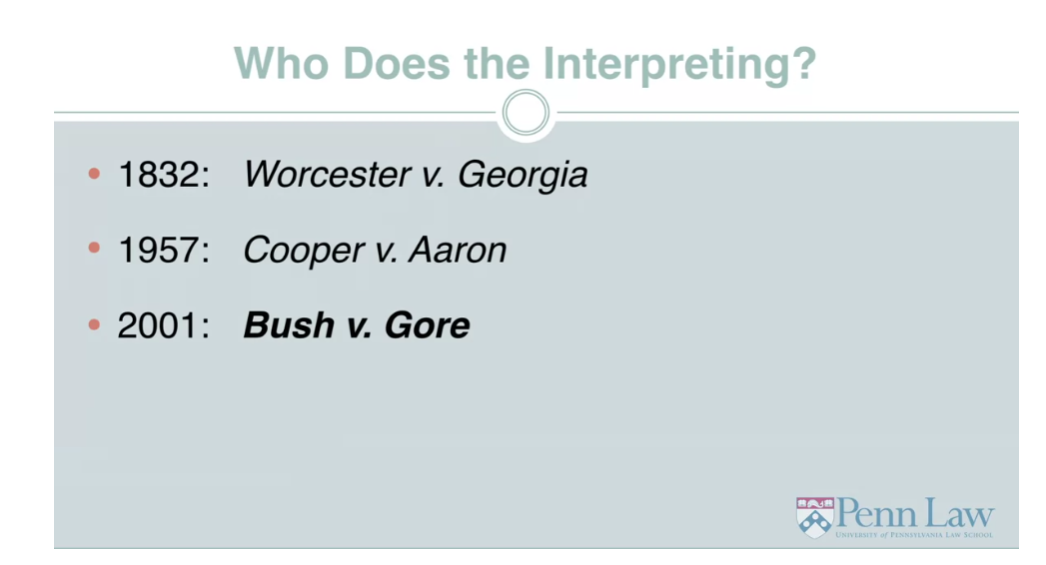
The point being we’ve had the text for
over 200 years of our constitution. We’ve had the Supreme Court for
over 200 years, but this nuanced and sophisticated acceptance
of the role of the Supreme Court. And the enforcements of its decisions in
our constitutional culture is something that it took quite a bit longer to attain. And this is a lesson and an instructive
one I think for those who say that US constitutionalism is being exported
around the world to other countries. It is true that that is being done, but to truly export,
the US constitutional structure. We need to do much more
than export the text. Instead, we need to export the text and
the institutions, and in some cases, perhaps wait for the passage of time in other nations that
don’t have a constitutional tradition in order to have the kind of
framework that we have here. [MUSIC]
Constitutional Law: Part 2
[MUSIC] Let me turn next to the next
part of this segment. Which deals with the structural
provisions of the constitution. How the government is set up and
structured. When the framers met here
in Philadelphia in 1787, they were primarily concerned with
this part of constitutional ordering. Bear in mind, they had just split away
from a government which they thought was terribly structured, giving far too much
power to the whims of a given monarch. And in setting up the new
American constitution, in light of the failures of the Articles
of Confederation, it was important for the framers to get it right and
give the right kinds of power and the right amounts of power to
different parts of government.
Here we turn once again to
the views of James Madison, and the most important of the framers who was
a student of governmental structure and proper allocation of authority,
and thought quite a great deal and wrote a great deal about the best
way to structure government. And he acknowledged a basic challenge
which I’ve alluded to before. First the framers sought to give
the government enough power to control the governed, but then structure it in
such a way as to use Madison’s phrase, oblige it to control itself. For Madison the solution to this dilemma, sought in, actually, lay in the basic
ambition of the men and, today, men and
women who occupy spots in our government. Recognizing, then, as now,
that the inherent ambition of people, who would seek places in government. Madison and the other framers sought to
build a government where this ambition was a built in feature. And one that would perhaps solve the
problem of too much ambition in one place.
So as Madison said, ambition must
be made to counteract ambition. The interest of man must be connected
with the the constitutional rights of the place.
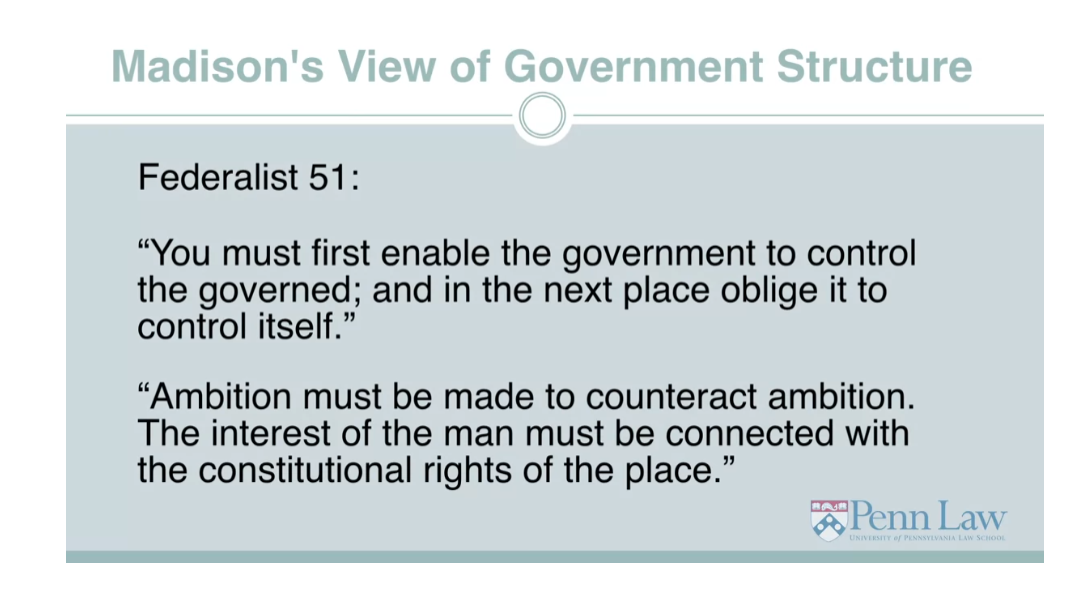
For Madison this meant
that the best solution for structuring government was dividing
power and creating incentives for one branch of government
to counteract the other. We call this separation of powers or
checks and balances. And the framers cared so much about this that they didn’t
just do it on one dimension. But they did it on two dimensions. And here what we mean is when we
talk about separation of powers in the federal government we often use the
phrase horizontal separation of powers. Splitting the government into three
branches, executive, legislative and judicial, and
giving each one of them certain powers and more importantly propose this theory of
behavior that Madison advances giving each branch the incentives to counteract and be somewhat jealous of
the other branch’s power. But, the framers didn’t
just divide constitutional, our constitutional order that way,
they also did it on, what we would call, a vertical dimension, namely, dividing
power between the National Government and the various state governments. This is a principle we call federalism and
it is very important even today, as certain things are certain
important policy choices are situated with the states, even as
many important policy objectives have come to be viewed as national
government prerogatives. And it’s on these two dimensions, the horizontal separation of powers
within the federal government and the vertical separation of powers between
the states and the federal government. Where our greatest debates over
governmental structure continue to reverberate in the Supreme Court and
in the broader public policy debates.
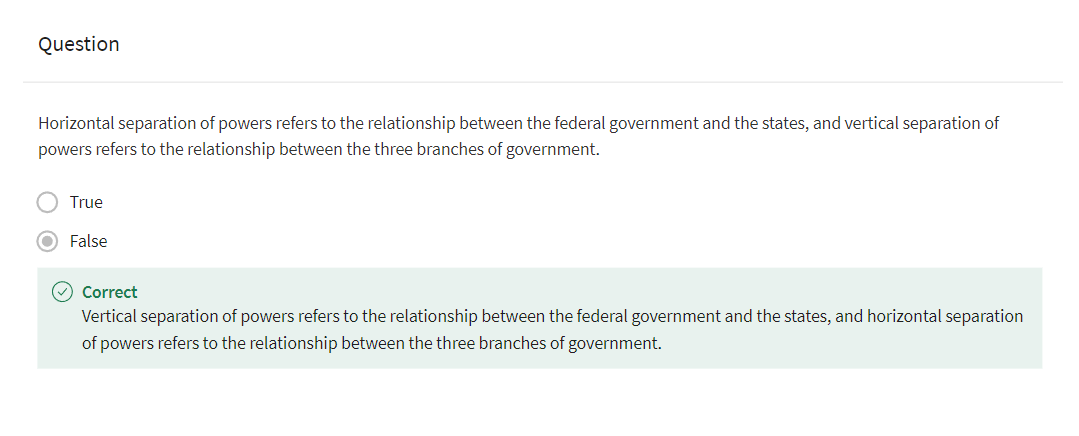
James Madison’s fundamental
insight that power was more safely reposed in government. When it was broken up into smaller chunks
and given to different branches or even different governments
as between the national and the state government is one that
remains important today even as we debate the precise boundaries
of those divisions. For the modern Supreme Court it
has been important particularly in the last few decades. Justice Kennedy in a representative
statement in a case called U.S. Term Limits versus Thornton called
Federalism Our Nations’s Own Discovery. And he talked about the framers splitting
the atom of sovereignty as a genius idea. Giving our citizens two political
capacities, one state and one federal, each protected
from incursion by the other.
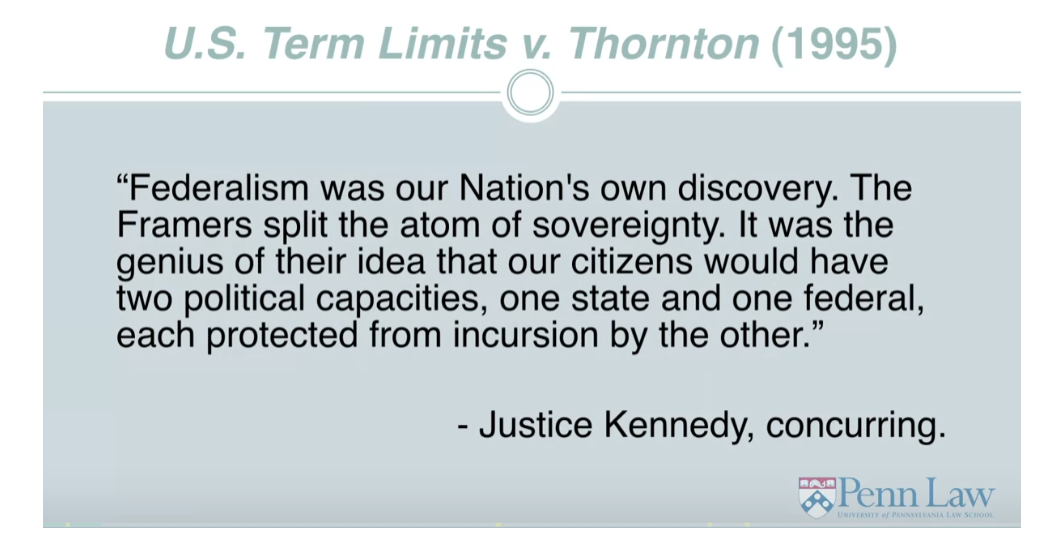
Now Justice Kennedy’s statement may
be a somewhat idealized version of our federal order. In reality, many,
perhaps most public policy issues are, are shared between the state and federal
governments, who cooperate or conflict or wrangle over the proper
sphere of authority. But still, for many citizens and
many judges, and many policy makers. This question of where we allocate
authority in our constitutional system remains crucially important and as hotly debated today as it was
over 200 years ago in Philadelphia.
Now the way that the Supreme Court and
others have operationalized these broad general principles about sep,
separation of powers. Is through the development of specific
doctrines in particular cases. Recall what I said earlier that
the basic framework parts of the constitution don’t come with
definition clauses or users guides. It has been the task of subsequent
generations over the past 200 years to give content to these broad general
principles, like executive power, legislative power, judicial power, or the
broad principles that there ought to be some separation between the states and
the national government. And the way the Supreme Court has done so
is, over the past 200 years, to very gradually,
very incrementally craft different doctrines that go to both separation
of powers on the horizontal level and the vertical level, the so
called federalism doctrines. It’s useful to divided this
general concept of separation of powers into three basic areas
of doctrine and analysis.
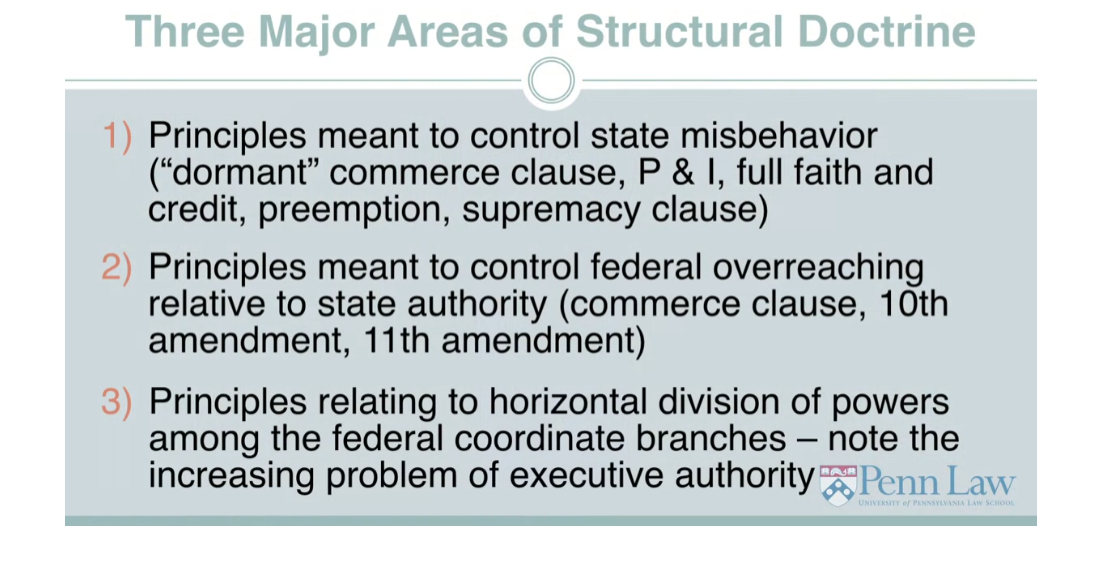
The first of two of which deal with
relationships between the state and the federal government. The third deals with the, what we call the horizontal relationship
across the federal government. So first the Supreme Court has applied the
Constitution over the past two centuries in ways to control the states and
limit state behavior, or even misbehavior. Second, and increasingly in recent
decades, the Supreme Court has applied Federalism doctrines to restrain the
Federal Government as against the States, to say that there are some spheres where
the Federal Government can’t legislate, no matter how powerful it may claim to be. And finally,
there’s another set of doctrines that are continuously under development and
debate that attempt to create limits between the different
branches of the federal government. And occasionally the Supreme Court will
address cases that asks the question, is the president
exercising too much power. Has Congress overstepped its bound in,
in this case? I’ll speak to all of these
doctrines in the next few minutes.
But I want to highlight yet another debate
in this area, which is the question of who should decide these major
separation of powers questions. To be sure, the Supreme Court has
asserted that it has the right to decide these fundamental questions
of governmental structure just as it does other questions of law and other
questions of individual rights protection. But there is a long scholarly tradition
rooted in constitutional history that suggest that these basic structural
choices about the constitution ought to be what we call non justiciable. In other words, decided outside
the courts by the major political branches of American government. After all, remember James Madison’s
phrase ambition must be made to counteract ambition. For Madison at least, the government
is already properly structured, so that if the President overreaches,
Congress ought to step in and reign in Presidential power. Conversely, if Congress is
exceeding its authority, perhaps the President will
refuse to enforce that statute. And there’s a real question about
whether the Supreme Court needs to referee all these disputes. On the other hand,
developments that Madison and his colleagues never could have foreseen
have complicated the separations of powers mix on all of these dimensions,
and perhaps given rise for stronger arguments for
judicial supervision. For instance, the framers for
all of their wisdom, never anticipated modern political
parties and the modern two party state.
And the implications that the two,
two party system would have for separation of powers. When the same party controls both Congress
and the White House the assumption that ambition will counteract ambition, and
Congress will reign in the President, falls apart in a world of
strong party discipline. Likewise, the framers never foresaw
the dramatic rise and the size and scope of the federal Executive branch that
has taken place over the past century. In the early days of the Republic, the federal government had only a few
thousand, non-military employees. Today the federal government has
over a million such employees. Growth of the federal government over
that phase has, some would argue fundamentally tipped the power of the
presidency relative to the other branches. These are questions that
are still debated, and that I’ll return to in a few minutes.
Now let me go somewhat more systematically
through these different areas of doctrine. The first area where federalism doctrines
have been applied by the supreme court and are baked into the constitution deal
with controlling state behavior or even state misbehavior. Indeed, were we to travel
back in time to 1787 and asked the framers what
they worried most about. They would not have worried about
an overreaching federal government. After all, recall how weak the federal
government was under the Articles of the Confederation. What they worried about, and the reason
they came back to Philadelphia in 1789, was that states were behaving badly. States were printing their own money
to let their own debtors off the hook. They were couldn’t agree
on state boundaries. They couldn’t agree on foreign policy, or policy toward the Native American tribes. Each state was going in its own direction. States were enacting internal tariffs and trade barriers, of the sort that
today we see between nation states. But this used to happen between
Pennsylvania and New Jersey. The Framers regarded this as no
way to run a proper country. And so one of the first things
the constitution did was prohibit and provide doctrinal grounds for courts to prohibit states from engaging
in this kind of individualistic behavior.
A later justice,
an important justice from mid 20th century Justice Robert Jackson said that
these clauses taken together were to declare something he called
a Federal Free Trade Zone. So if you imagine efforts such as our
undergoing these days in Europe to create a, to transform what used to be
individual markets into a national free trade zone, that was a major impulse of
the early days of the Constitution, and largely successfully enforced by the
Supreme Court over the last two centuries. Such that these debates occur,
but occur much more, much less frequently than they would
have in the early days of the Republic.
Dormant Commerce Clause:
The Commerce Clause of the Constitution gives Congress the power “to regulate commerce among foreign nations and among the several states.” The Supreme Court holds that there is also implied a “dormant commerce clause” that prohibits individual states from regulating commerce affecting other states. Only Congress has this power.
Modern debates over the scope of federal
government authority often grapple with the fundamental tension and inconsistency
that’s built into the Constitution. On the one hand the baseline rule in the Constitution is
that power resides with the states and the people, and the national government
only has those powers that the document. And interpretations of
the document affirmatively give to the national government. This is called the doctrine
of enumerated powers. And it is often invoked by people who
say that the federal government is over-reaching its authority, because it
can’t point to a certain enumerated power. On the other hand, some of the enumerated
powers themselves are extremely broad and extremely vague. The most important of these is the
Commerce Clause which gives the national government the authority to regulate
commerce among the several states. And today the Commerce Clause
stands as the foundation of much national government authority. Now the meaning of this clause typically
is not defined in the Constitution, and has been contested heatedly over the past
two centuries, indeed over the past few decades, in the context of major statutory
enactments like the Affordable Care Act. It’s possible to think about the Commerce
clause and the history of its development in four main historical epochs, and
I’ll summarize these briefly here.
First, for much of the first hundred
years of the constitution’s life, until about the 1870s or
1880s Commerce Clause cases were few and far between, precisely because the
National Government didn’t do that much. In a series of decisions, in this period,
that might surprise modern observers. The Supreme Court took a very narrow and formalistic definition of the Commerce
Clause, and, issued decisions saying things like manufacturing in a major
sugar plant was not commerce and therefore that company was not
subject to basic anti trust laws. Or even more strikingly
a factory that employed chird, child workers was not engaged in commerce. Therefore the National
government had no basic, no authority to issue basic
child labor legislation.
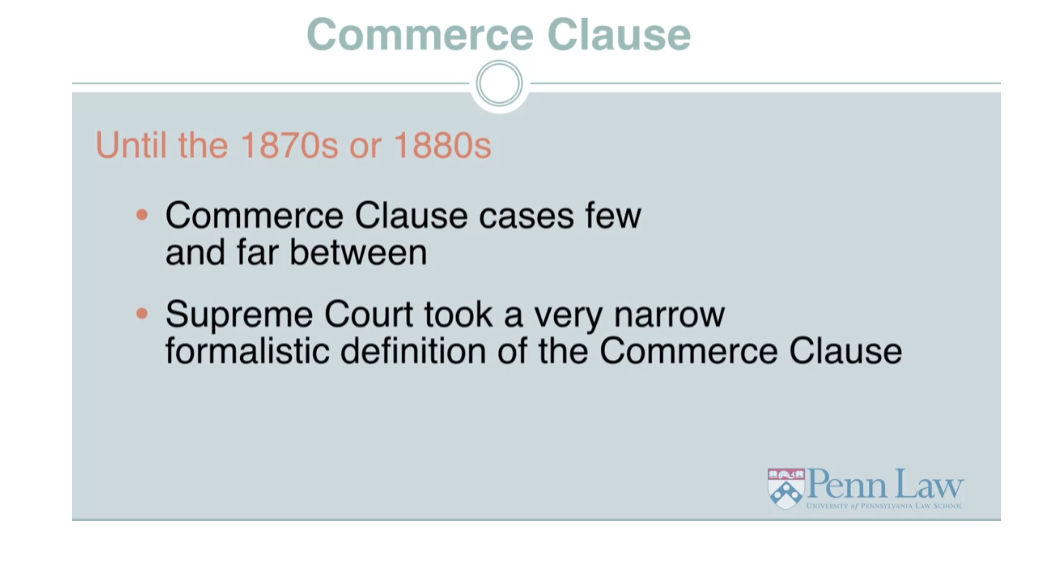
This was a constitutional regime,
which seems anachronistic to us, and indeed it proved unsustainable,
even in a much earlier date, namely in the New Deal in the 1930s and
the 1940s. After the Supreme Court struck down some
of President Franklin Roosevelt’s most popular and important recovery
initiatives President Roosevelt capitalizing on public dissatisfaction
with a court that seemed to be stuck in the past proposed what
would have been a radical solution, namely adding more justices to the Supreme
Court in order to reverse those rulings.
Perhaps sensing the public
outcry against its decisions and wanting to avoid the constitutionally
problematic strong arming from President Roosevelt,
the Supreme Court, by the middle of the New Deal reversed its prior narrow
interpretation of the commerce clause and adopted something much more familiar to
the doctrine we have today from the court. Namely, that commerce is defined pretty
broadly to include any activity that affects the national economy,
however small, so long as if taken in its totality in an
aggregate sense it has an economic impact.

So this is the law today and
indeed the law from, from about The New Deal Era, up until the
time I was in law school in the mid 1990s. Was that congress could do pretty
much what ever it wanted under the commerce close. There wasn’t any real enforcement of
federalism limitations in this area. We are now in a different era, with a more
aggressive, robust Supreme Court, where at least five justices on the current
Court maintain that there are limits to national government power and that
the Court aught to enforce those limits.
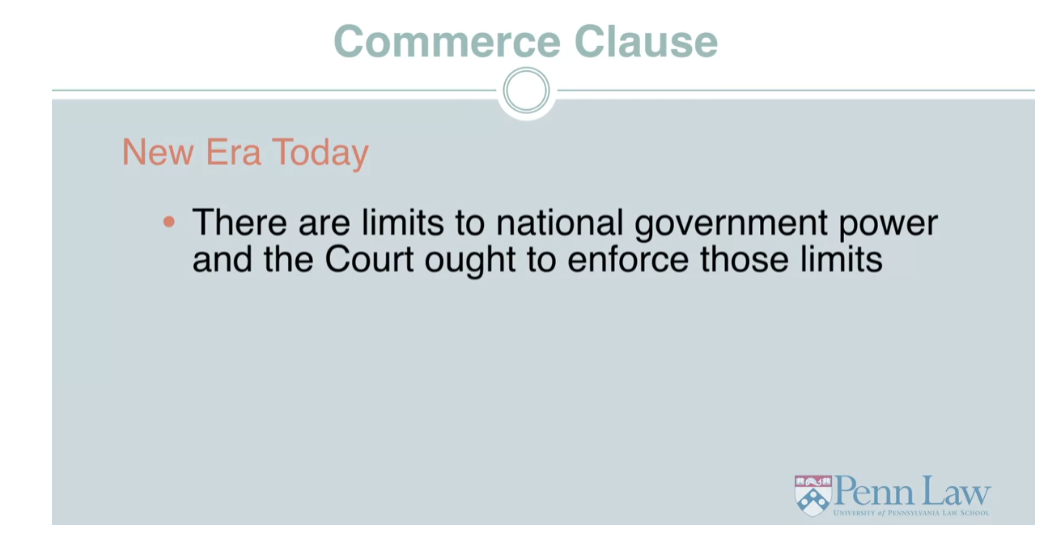
And we saw such a case just
two years ago with the major Affordable Care Act case of 2012,
where a slim majority of the Court felt that a key part of
that statute, the individual mandate, was beyond the Federal Government’s
authority on commerce clause grounds. Because it sought to legislate
in the Court’s view. People who weren’t doing anything but
sitting around. And indeed the entire validity
of the Affordable Care Act was only upheld on a different ground
the so-called taxing power. Because the the burden or
the penalty that falls on people who didn’t pay the individual mandate is
operational as through their tax returns.
The Supreme Court found that the Affordable Care Act could not be upheld based on the Commerce Clause because what the Act was doing – asking people to buy health insurance – did not really affect interstate commerce. The Act could be upheld as an exercise of Congress’s taxing power.
So we’re in an era now where federal
government authority is vast but the Supreme Court assertively maintains
its prerogative to enforce that. There are many scholars and many in the
policy world who feel that these kind of federalism restrictions to control federal
government overreaching are important but ought not be enforced
by the Supreme Court. Indeed keep in mind the structural
provisions that are built into the so-called political branches,
that are built into Congress itself. and, and the argument goes includes
plenty of protections for the states. Each state gets two votes in the Senate. No matter how big or how small. So that a state like Wyoming has as much
representation on a state-by-state basis as a state like California. Despite vast discrepancies in population. For many observers, this suggests
that state interests are fully protected in the actual voting procedures
and political process in Congress, and that the Supreme Court ought not get
involved, in policing this boundary. It ought to stick to protecting
individual rights and standing up for the rights of entities and
individuals who don’t have a voice in the political process,
whereas states do have such a voice.
But clearly, as a statement of
current constitutional law, the Supreme Court has come out
strongly in the other direction, saying that it can and will enforce
these federalism restrictions.
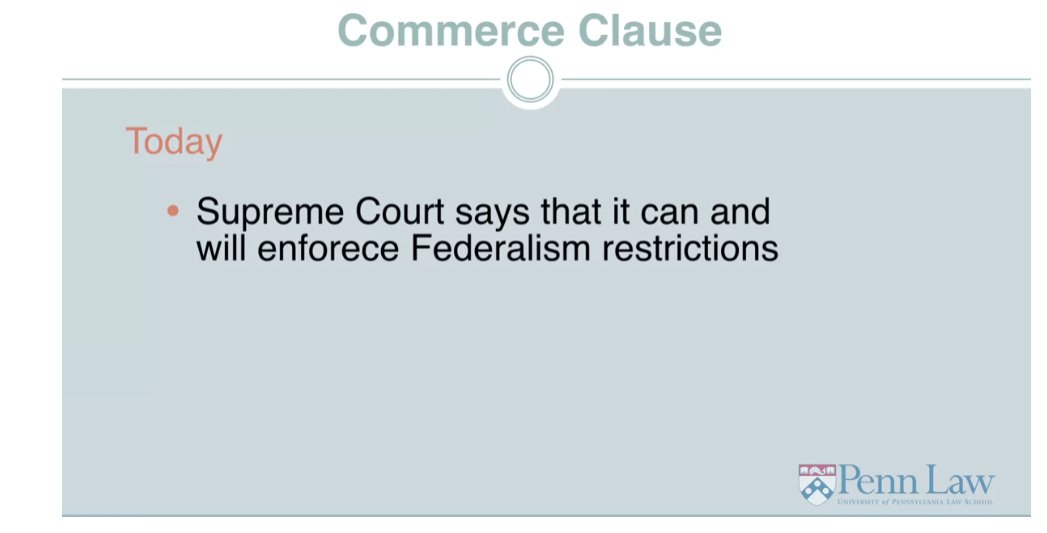
I’ll now speak about a different
element of separation of powers. Now, in here we’re talking about the
horizontal separation of powers between the different branches of
the national government. This is the area where both today and historically Supreme Court
doctrine has been least helpful. I think precisely because
the fundamental definitions of these different branches are so
unspecified. Legislative power, executive power, judicial power
are undefined in the Constitution. And the precise contours and,
and boundaries of those concepts have become evermore
muddled as the government has grown, and changed, and become more complicated. For instance,
take an agency like the Food and Drug Agency, which regulates the safety
of food and therapeutic products,. The FDA is an executive branch agency. We know it is within the executive branch
but if we look at its functions it does some things that look like
executive enforcing of the laws. It had the authority to inspect and
enforce rules, say, against pharmaceutical manufacturers. But some of what it does looks
a lot more like a legislature. Like many agencies,
the FDA has authority to write rules which are binding and generally applicable and
look a lot like statutes. We call them regulations and thus place
them in the executive branch, but functionally, that behavior
looks much more legislative. Other agencies have the ability to
adjudicate actual cases and disputes. For instance the Social Security
Administration has its own judges who hear debates, or
hear disputes when somebody claims to be denied the proper amount
of benefits exercising very much a judicial function again despite
technically being in the executive branch.
For this reason,
the growth of government in ways that the framers never could have intended
have put pressure on these basic definitions inherent in the horizontal
separation of powers and confounded easy judicial techniques for drawing
bright lines between such branches. Today in this area courts are struggling
with issues like national security surveillance by the executive branch
the power of the President to wage war in foreign countries despite
not formally declaring war and the growth of congressional behavior and
congressional oversight activities which raise questions
about congressional overreaching. In these areas, there’s a real question
of how much the Supreme Court, or any judges can do,
to meaningfully police these boundaries. As I’ve said, the fundamental definitions
in the Constitution are so vague and unspecified, between executive,
legislative, and judicial power. That, articulating meaningful
doctrinal standards to channel and cabin these different types of
power have proven over the past two centuries to be largely unworkable.
Moreover many of these decisions,
such as whether or not to send troops to a foreign
country are probably the worse kind of decisions to vest in a group of unelected
judges who take a long time to hear cases. And perhaps ought to be worked out
more within the political process. Certainly James Madison and the other
framers envisioned that Congress and the President would be their
own best check on each other. That Congress would check
the President when he or she overreaches, and that the President
would check or refuse to enforce or would veto congressional laws that
represent where we are reaching. In here I will return to though a problem
that the framers never foresaw but that is essential part of our political
community today which is the rise of disciplined fairly powerful
political parties. Although, the framers envisioned politics. They didn’t in, view,
vision political parties. And, the notion of a strong disciplined
party controlling both Congress and the White House, undermines many of the
structural protections that Madison and the other framers thought would
work to control over-reaching. Simply put, when the President and Congress are of the same
party who will rein in an overreaching President if the President
indeed is the leader of his, his party? And we’ve seen, seen examples. Whatever political party or persuasion
one is, you can think of examples when Republican presidents have seemed to exert
dramatic authority unchecked by Congress. And you can think of recent examples
of a Democratic presidents have seem to exert unusually robust authority
largely unchecked by Congress. This is something
the framers never foresaw. And it’s a fundamental feature of our
political process which puts pressure. And perhaps stretches
to the breaking point. Some of the basic allocations of
authority in in the national government.
These are problems for which the court
probably doesn’ have a solution and it’s up to the rest of our
constitutional culture and other institutions: the public,
the president and congress. Perhaps working together going forward
to better structure and allocate power. This is not an area where an easy
doctrinal solution exists. So to sum up this entire
separation of powers discussion, I think we see two very different problems,
or two very different phenomenon. In the, in the Federalism context
the debate between state and federal authority and
in the horizontal separation of powers, context arrayed across
the federal government. When it comes to judicial control of
national government authority vis-a-vis the states, the current Supreme Court
has been very assertive, very robust and articulated very clear rules. In ways that many think have gone too
far in asserting judicial protection. On the other hand, when it comes
to presidential authority and overreaching many feel that the court
has not done enough to articulate clear meaningful standards to cabin executive
power in the 21st century, as it grows in ways that the framers never would
have imagined over two centuries ago. So these are the two competing
challenges in this area, that the court. And the rest of our constitutional culture
we’ll need to address going forward. [MUSIC]
Constitutional Law: Part 3
[MUSIC] This next part addresses a part of
the Constitution that many people think of first and foremost when they think
about the American Constitution and the protections that it affords. And here I’m talking
about individual rights. Rights such as freedom of speech,
freedom of religion, the right to be free of
discrimination based on race the protections that one
has as a criminal defendant. These are the rights which many people
associate most predominantly with constitutionalism and constitutional
protection and they are a part of the American constitutional order that
was there almost from the beginning, but has developed in dramatic fashion
over the past 50 or 60 years. The regime we have today for protecting individual rights looks
dramatically different than it did 100 years ago, and certainly dramatically
different than it did 200 years ago. This is a subject which can, and in, at many law schools does occupy
an entire semester long course but here, rather than focus on specific individual
rights, I want to draw together and emphasize some general themes that I
think, situate the individual rights jurisprudence of the American
Constitutional order within the longer textual and historical tradition that I’ve
been talking about during this segment.
And I can focus on a few
major points along this line. First, as I’ve alluded to before,
the text of the constitution vis a vis individual rights, just like it is
in other sections is remarkably sparse and undefined and, the mere words on
the page don’t do the work in protecting individual rights that our constitutional
culture has come to want them to do, and I’ll offer some examples here. Second this is an area where we’ve
seen dramatic changes over time in the national enforcement of
individual rights guarantees. Our constitutional world is fundamentally
different today that it was a century ago and changing even year by year, decade, decade by decade
in some ways I’ll discuss. Third, I want to address two fundamental
general doctrinal innovations that the Supreme Court has operationalized
over the past century in building the Constitution of
individual rights that we have today. The first of these is
the concept of incorporation, the idea that rights which as written
in the document’s text apply and constrain only the national government,
have been made applicable and universalized within the American
constitutional order to bind all government actors,
national, state and local.
Next, another general doctrinal device
which is quite important is the concept of balancing, or a nuanced standard of
review, that the justices apply in particular cases across a wide range
of individual rights areas: race discrimination, sex discrimination,
religious freedom freedom of expression. And here, the basic notion is that
no individual right is absolute. In the, in our constitutional discourse
the claims of individual rights holders are and must be balanced against
compelling claims by society at large for a different result. And this in, to a large, great extent, is the project of American constitutional
law in the individual rights space. It is the specification of which rights
are worthy of special protection that, there, then, that therefore,
demand especially good or compelling reasons from the government
in order to affect those rights. And its this shifting denomination of
which rights are important enough to, to demand particularly good reasons from
the government that is a large part of what the judges have done in, in construing the Constitution over
the past half century or more. Fourth, I’ll briefly address what’s
evident when one considers the development of individual rights doctrines
over the past several decades, the somewhat permial, permeable boundaries
between formal constitutional doctrine and public opinion about those rights.
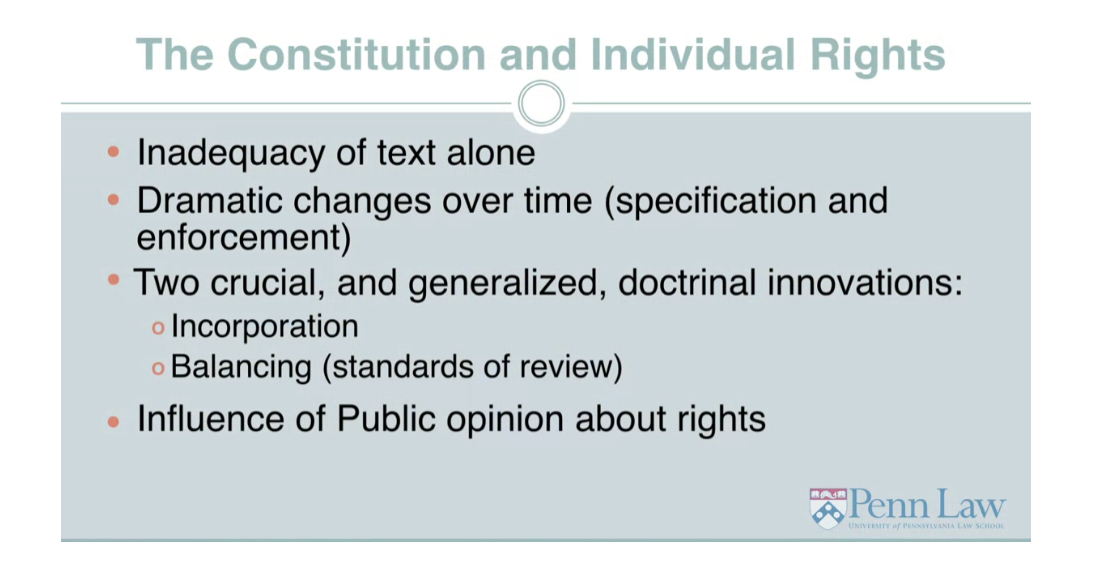
Simply put, as society decides that
protecting a given interest is relatively more important, we would expect to see and
we do see doctrinal shifts in the judicial protection, the constitutional
protection for these rights. Nowhere is this more evident than in
the dramatic change in the manner in which the courts protect rights for certain
same-sex individuals, or even individuals to engage in same-sex relationships, and
I’ll speak for a few minutes about that. finally, as important as the Supreme Court
has been and still is in protecting individual rights, there
are those who wonder, and, and a question that’s worth posing is, is the court too
powerful or too supreme in this area? A question to consider is whether our
rights would be even more firmly grounded if we asked and expected legislatures,
executive officials, police departments, and other institutional actors
to take seriously these rights, instead of leaving them for
judicial resolution.
I’ll address all of these briefly in turn. First, let me turn to the concept of how
inadequate text is sitting on the page alone and here I’m going to use
two textual guarantees of rights. The first here, Congress shall make no
law abridging the freedom of speech, or the press; or the right of people
peaceably to assemble, and to petition the government for
a redress of grievances may be familiar to some of you if you’ve
read the US Constitution. This comes right out of
the First Amendment of our Constitution. Now the second clause here looks good,
as well. Citizens are guaranteed freedom of speech,
of the press, of assembly, demonstration and association.
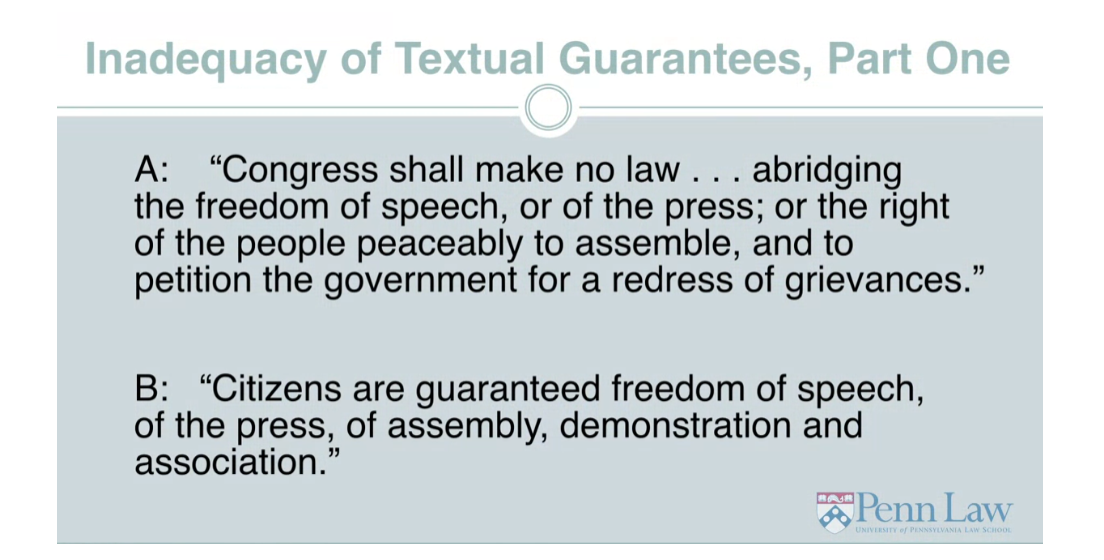
This seems to protect the same freedoms,
indeed it was likely modeled, on the United States First Amendment
as it came afterwards. The second clause I read, labeled as
B on the slide, actually comes from the North Korea constitution, where we
know that despite these paper protections, citizens dramatically do not have the same
protections as they do elsewhere. And this is a vivid and perhaps almost too
extreme example of the disconnect between mere words on a page and the institutional
and cultural protection of those rights. If the North Korea example seems extreme,
I’ll turn to a more accurate historical example from
our own constitutional development. This text comes from our own Constitution,
the 14th amendment, we call this the equal protection clause. No state shall deny to any person within
its jurisdiction the equal protection of the laws.
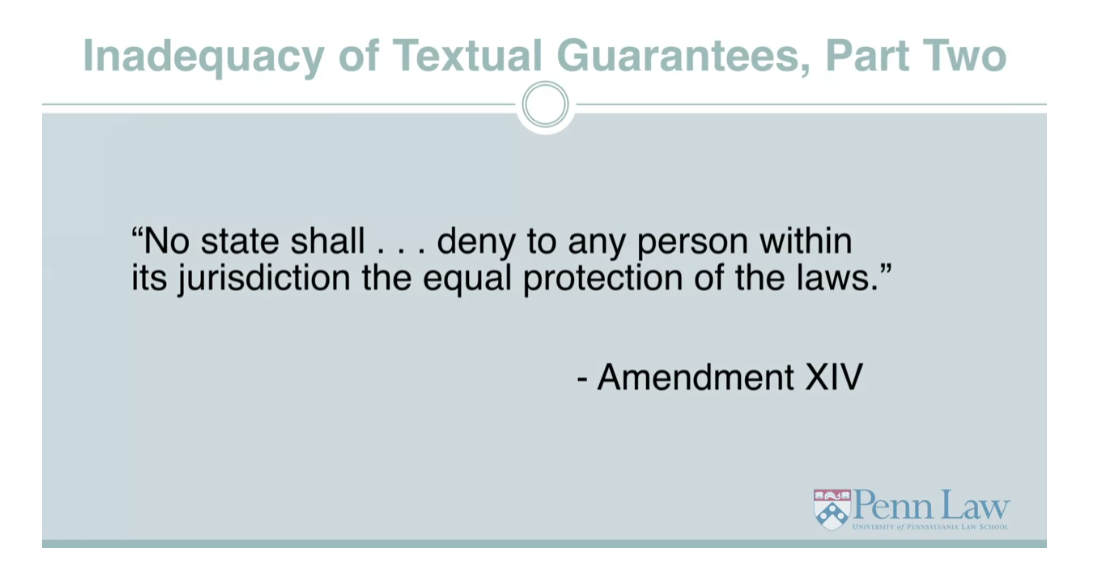
It today is on, one of the most
fundamental personal protections against government discrimination and it forms a
core fabric of our Constitutional rights. This amendment was enacted in
the immediate aftermath of the Civil War, in the late 1860s and so
it has been on the books for almost 150 years as the Constitutional
law of the land of the United States. Now, as our history shows, for the majority of this amendment’s life,
these words were as unenforced as the words of the North Korean Constitution
I showed you a few minutes ago. These words were on our books through a
period in the early, late 19th century and early 20th century of brutal oppression
and Jim Crow segregation in the South and, dramatic discrimination against African
Americans throughout the entire country. As these examples illustrate,
words on the page by themselves, are inadequate protections
of personal freedoms.
What is needed is a more thick
institutional culture of enforcement and acceptance, to operationalize those words. To illustrate this point further I’ll use
the words of Dr. Martin Luther King Jr., very early in his life actually as a high
school student when he gave an award winning speech precisely on this issue
of the empty promise of amendments on the pages of the Constitution
without more effective enforcement. King said America gave its full
pledge of freedom 75 years ago and backed it with amendments to the national
constitution where there should no discrimination based on race or
other criteria.
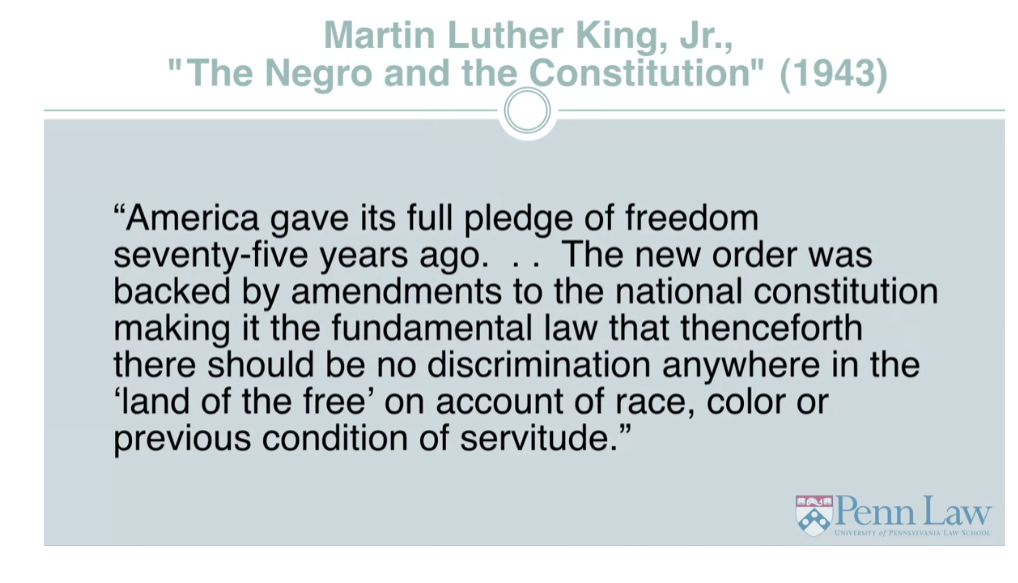
But as King notes, Black America,
in his, in, on this writing, Black America still wears chains. Thirteen million black sons and daughters
of our forefathers continue to fight for the translation of the thirteenth,
fourteenth, and fifteenth amendments from writing
on the printed page to actuality.
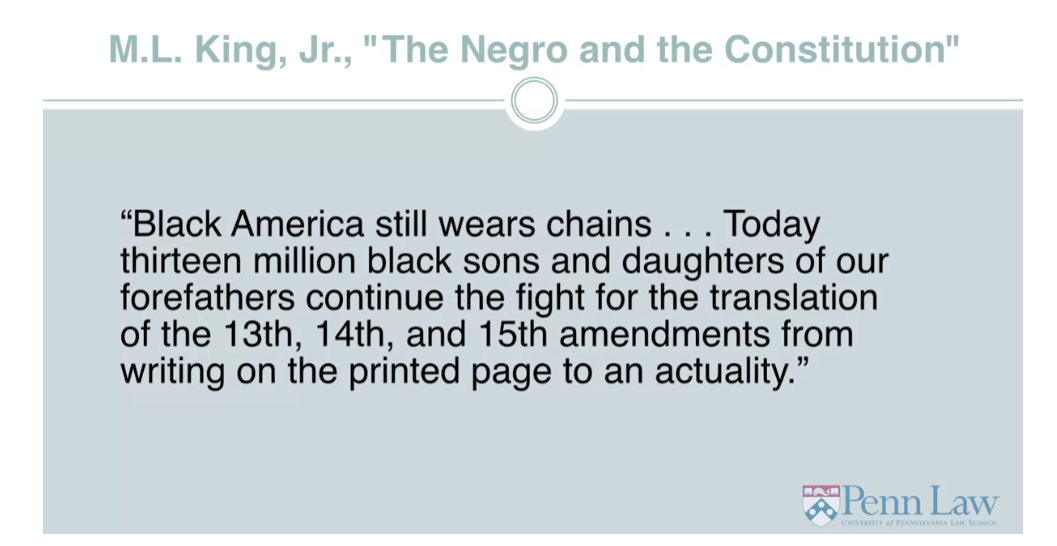
It’s this notion of translation that has
been a theme of this segment be it whe, whether it be in the separation of powers
area or this individual rights area. The words on the page don’t
interpret themselves and they certainly don’t enforce themselves. That requires an ongoing and
evolving societal commitment.
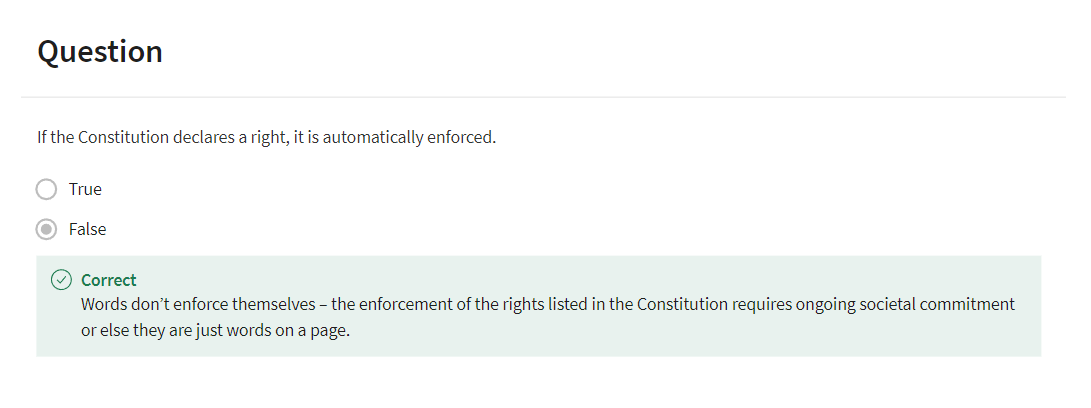
And this is what King both was
writing about in the 1940s and then participated in transforming and translating the meaning of the fourteenth
amendment into actual legislation and actual court decisions,
through the remainder of his life. I’ll now address two specific doctrinal
areas where the Supreme Court has constructed interpretive techniques and doctrines to engage in this project of
translation, that Dr. King spoke about. Without going into specific
areas like freedom of speech, or freedom of religion, or
criminal protections for criminal defendants, I’m focusing on two
general points that apply broadly across the landscape of individual rights in
the American Constitutional context. The first of these is this
idea of incorporation.

Incorporation is what
the Supreme Court did from the 1925, the 1920s through the 1960s
in order to universalize many of the most important individual rights
protections in our constitutional order. If you look at the Constitution’s text,
and here’s an example of the first
amendment it quite clearly says, Congress shall pass no law affecting
freedom of speech, press, etc. now, if one reads this literally,
one would think that only federal statutes must comply with First Amendment
scrutiny, that, say, state laws or local police enforcement could transgress
religious freedoms protection or throw people in jail for writing something
in the media, and indeed, if one reads the text ab, absolutely literally,
it applies only to the National Congress. But of course,
that’s not the way we’ve read it or understand it in our society and have not
read it that way for almost a century. And this relates to
the notion of incorporation. What the Supreme Court did starting in
the early 20th century, was take certain basic guarantees,
like the First Amendment, which, by its terms, appears to apply only
to Congress and incorporate, or fold that into our concept of due process
of law, which through the 14th Amendment, applies to all governments, state,
local, and as well as national. And the Supreme Court did this for many,
indeed most of the core individual rights protections that we hold dear that protect
defendants in criminal trials, that protect freedom of religion, that protect
our freedom of speech and association.
And then the Supreme Court likewise
universalized the Equal Protection clause, which by its terms is written
only to govern states, and said that the national
government likewise has to abide by the core anti-discrimination
principles of the Equal Protection clause. So what the Court did through its process
of incorporation that took place over the better part of the half of the 20th
century was to universalize and operationalize the core
individual rights guarantees in the constitution which again,
by the text alone, would have seemed to apply only to
certain governments and not others. Today, the individual protections
that are most important to Americans apply as against all levels of
government, national, state, or local. And the core, the basic core of
individual rights guaranteed in the Constitution applies equally across
the nation and, and doesn’t vary, at least in terms of the National
Constitution, from state to state. So this was a key judicial move that
was unforeseen by the framers, but that has done, a great deal to operationalize the culture
of individual rights that we have today.
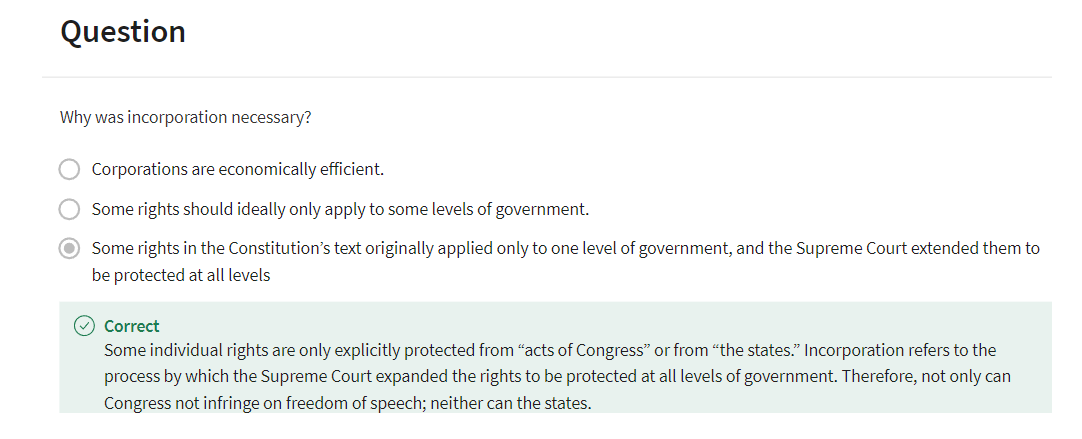
The other core judicial innovation that I
want to emphasize in that it spans a wide swath of individual rights doctrines is
the way in which the court, particularly in the late 20th century through today,
has articulated different levels of scrutiny and different levels of balancing
individual rights against other interests. One of things, one of the things that’s
clear when one thinks about individual rights is that no matter how
important a given individual right is that right becomes problematic when
it is applied in an absolute sense to an extreme at the expense of all other
rights or all other public values.
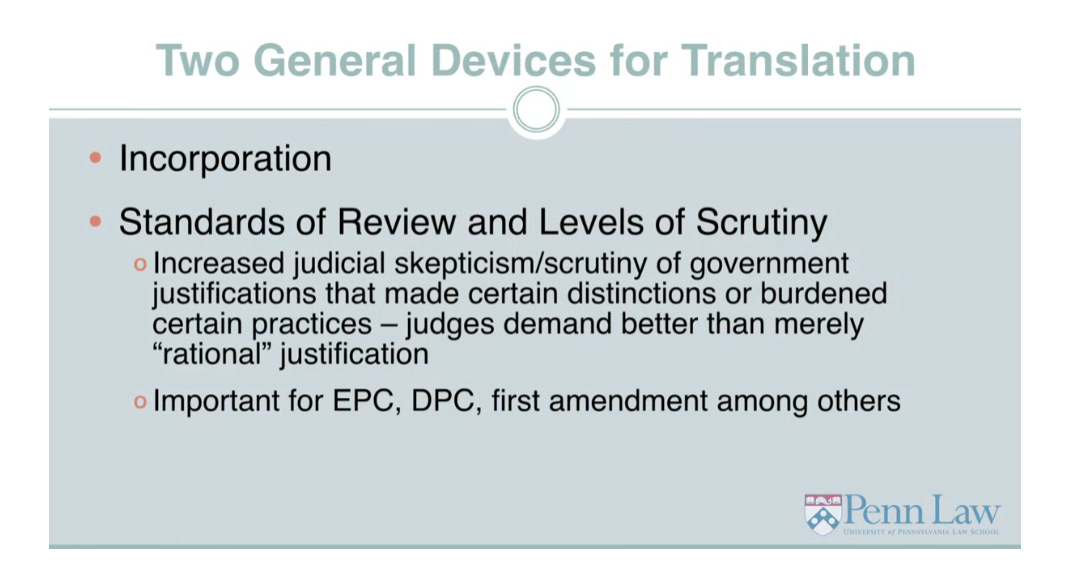
We live in a complex world where
often there are difficult and fundamental trade-offs between, for
instance the widely held desire for privacy in our personal communications and
the equally widely held desire for national security and defense against
threats that demand a certain tradeoff. We value freedom of religion deeply, but we also realize that there are certain
commitments and behaviors that we need to regulate universally in society
and not allow religious exemption. This fundamental tension is
generates much of the debates in, about individual rights in
our in our legal culture. And in response justices on the Supreme
Court over the past half century or more have articulated a set of
doctrines which apply broadly across individual rights that attempt to balance
these different competing considerations. And we think of these
as levels of scrutiny. The basic principle is that most of
the things government wants to do, it can justify against lawsuits if it
can articulate a merely rational basis. Essentially, as long as it
can give any decent reason it can justify a distinction it makes. So for instance the government
in its tax code draws lots of distinctions between how
certain things are taxed or different levels of tax that some
people pay as opposed to another. Clearly it creates inequality. But that inequality is not,
according to judges and others who participate in
constitutional interpretation, is not the kind of equality that
we ought to care deeply about, and to say we care deeply about in
a doctrinal sense, is to say we give certain problematic dimensions of
inequality, we give them strict scrutiny. What strict scrutiny means is,
and an example would be, when the government treats people
of different races differently, we are going to apply
the strictest possible scrutiny, given the problematic history
of racial differentiation. It doesn’t mean the government can never
differentiate on race, it just means that the government better have an especially
good, or compelling, reason for doing so.
Tiers of Scrutiny: the tests
- Rational basis: the government has any decent reason for drawing a certain distinction
- Strict scrutiny: government must have an especially good or compelling reason for drawing a certain distinction
- Intermediate scrutiny: in between
Tiers of Scrutiny: when they apply
- Rational basis: most government actions
- Strict scrutiny: when the government is doing something in potentially in conflict with the Constitution. For example, drawing a distinction based on race.
- Intermediate scrutiny: the Court has declared this is the test for when the government draws distinctions based on sex.
This debate became overt and becomes overt
whenever the Supreme Court takes a case about affirmative action in education,
as it did most substantively over a decade ago in the Grutter versus
University of Michigan case. And in that case the court upheld the, the University of Michigan Law School’s
use of race in law school admissions, but only because the law school made
a compelling case that governmental consideration of race in admissions
was necessary to build the kind of law school class to, that produced the optimal
learning environments and that produced the kind of graduates that employers and,
and other elements of society wanted. But, the only way that race,
could be considered in that case, was due a particularly compelling
justification, given by the university. This kind of tradeoff,
this kind of balancing, applies broadly, across a number of
different individual rights doctrine, and it’s something that’s been
constructed by the judges over time, in order to mediate this difficult
balance that I’ve been talking about.
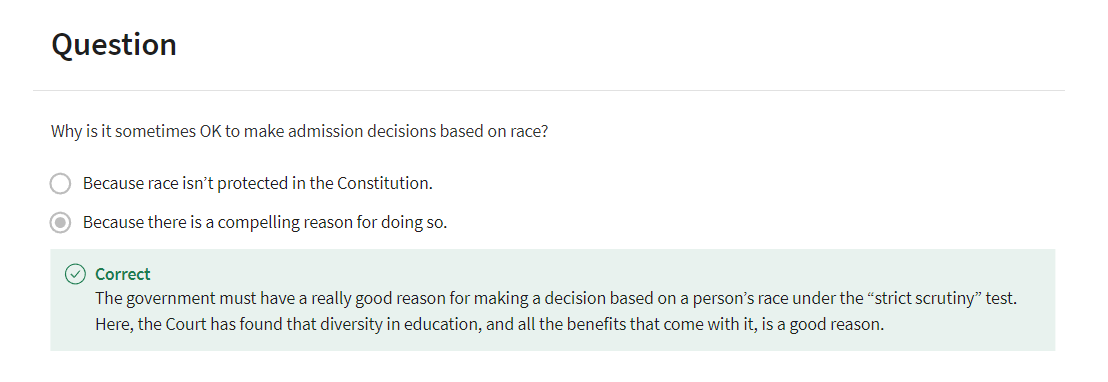
Not only does the balance mediated between
these competing considerations, but the way we weigh different interests, the
way we kind of do this judicial balancing, quite clearly changes over time, in
response to changes in public attitudes. This judicial balancing, this use
of the tools of different levels of scrutiny has been with us so,
for some time. But equally clearly,
the way judges strike the balance, the particular weights they put in the
scale in particular cases also change over time as some interests gain in importance. Others wane in importance and
this gives a certain dynamism to constitutional interpretation,
where some interests which even in very recent memory were disregarded
suddenly become more important. Thurgood Marshall who himself as a attorney arguing before
the Supreme Court in the 1940s and 50s helped shape our changing constitutional
understanding of race discrimination, then gave voice to this when he himself
was a justice on the Supreme Court. As in Marshall’s words here, the spectrum
of interests clearly show variations in the degree of care with which
the court scrutinizes classifications. And here I think it’s important
what Justice Marshall says. The way the court strikes this
balance depends, in his words, on the constitutional and societal importance
of the interest adversely affected.
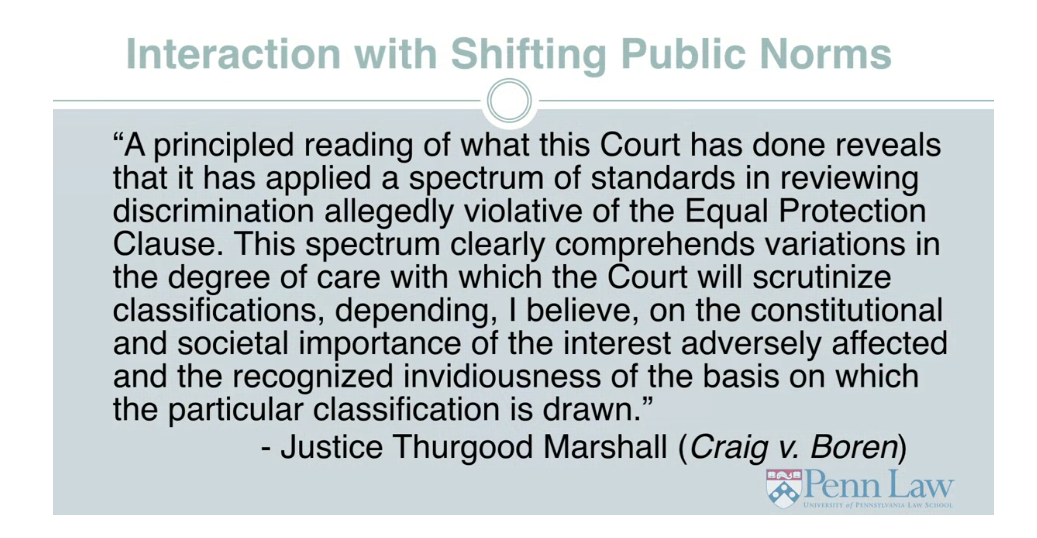
Simply put these
constitutional doctrines about individual rights have a certain
judicial structure but they are not entirely apart from the social structure
of the broader American community, and the values and weights that
America puts on given interests. Nowhere is Justice Marshall’s
sentiment more evident in recent years than in
the dramatically shifting doctrine that the Supreme Court has articulated
involving the constitutional, constitutional protections
of same-sex relationships. As recently as 1985,
in the case called Bowers versus Hardwick, a majority of the Supreme Court
upheld making it a crime for two consenting same sex adults
to engage in sexual relations. Less than two decades after Bowers, in 2003 in a case called Lawrence versus
Texas, the Supreme Court considered, considered and
explicitly rejected Its ruling in Bowers on the permissibility of criminalizing
same-sex consenting adult relationships. In Lawrence, Justice Kennedy writing for
the court declared the right to choose one’s own intimate partner as sacred and
undeniable and, wrote an opinion which explicitly overruled the court’s
prior precedent from only 18 years before. This is a modality we’ve seen on
other occasions through Constitution, Constitutional history, of course the
Plessy versus Fergon, Ferguson decision from the 1890s was overturned in Brown
versus Board of Education in 1954.
And in many other areas, but
rarely so rapidly as in the area of the permissibility of same-sex consenting
adult relationships, and the speed with which the court overturned its Bowers
precedent corresponds with an equally quick shift in public attitudes on
the acceptance of same sex relationships, which is today translating into
rapidly changing legal norms and constitutional norms in
the area of same sex marriage. This is an area that we’re more vividly
than most, and more rapidly than most, but just as assuredly in other areas we see
that the legal work that the court does is not inherently sealed or divorced from
the public opinion in the broader society. And this is one of the engines that
generates constitutional change. It’s not that the constitution is living,
but we the people are living. And our changing attitudes
clearly inflect and ultimately affect the way that
the Court interprets this document.
Finally, after all of this
discussion of the Supreme Court and its important role in
protecting individual rights, it’s important to remember as the framers
did that all involved in government and society have some role in protecting
these basic individual guarantees. Indeed a society that relies
exclusively on a group of unelected judges as the sole
guarantors of individual rights is risking those
rights diminishing in dramatic ways. This is particularly true in areas where
individual understandings of rights, such as privacy, are under increasing
pressure, and very rapidly so today through technological change that
the law struggles to keep pace with. In such areas, rights protection
will be most effective if the, the more responsive branches of government
like the executive branch agencies and the legislature itself are in
the forefront of protecting these rights. And sometimes even the justices themselves
recognize this, that they are not the best Institution to stand as a bulwark against
these rapid technological changes.
Justice Alito in the recent,
Fourth Amendment case US versus Jones which involved whether
a continuous GPS surveillance device attached to a car for many days
created a Fourth Amendment violation expressed this notion of institutional
competency in the language you see here. For Alito at least, the best solution
to privacy concerns may be legislative. And Alito’s views are shared
by his others on and off the bench, particularly,
in areas like this.
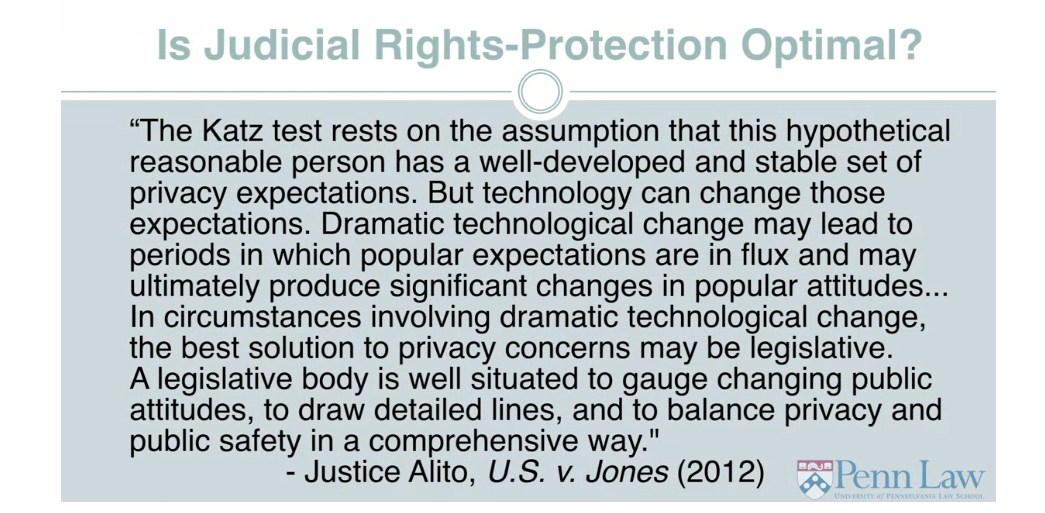
We’ve seen it also in the, in areas such
as race discrimination where Brown versus Board of Education in
1954 was an iconic and important Supreme Court decision
in outlawing segregated schools. But, for the lives of minority
individuals in the United States, much greater gains came a decade later
with the Civil Rights Act in 1964, a congressional statute, which because
backed with the full enforcement apparatus of the federal executive branch, worked
much greater change in people’s lives than the Brown versus Board of Education
decision coming from the Supreme Court. So this is the last theme to remember
as we talk about the importance of individual rights. The importance of the court in translating
and enforcing those rights is that as much as the Court does, we cannot ask the
Court to do everything in protecting these rights, and it’s important for
any Constitutional culture to remember the role of other branches and
the public itself in operationalizing and giving shape to these foundational
individual guarantees. [MUSIC]
Constitutional Law: Part 4
[MUSIC] Finally, I’ll end this
segment by talking for a few minutes about the role of the United
States Constitution in the broader world. You’ll recall, from the beginning
of this segment that the U.S. constitution is the oldest constitution
in the world operating today. It was quite unique when
it was framed in 1787. And it has been held up by commentators
both in prior centuries and very recently as a model for
constitutionalism around the world. To a great extent, this story of influence
is accurate, at least in general terms. When the U.S.
Constitution was framed in 1787, it was virtually the only written
constitution in the world. It was an outlier. And it was viewed as a novel experiment in
writing down the rules of the governance. Today, that novel experiment
has become the world’s norm. Virtually every country today with
only a handful of exceptions has a written constitution, has a Supreme Court which exercises
some form of judicial review power. And has a culture of both governmental
structure and individual rights that mimic, at least faintly, the American
Experiment from two centuries ago.
So this is in, in one very broad, very general sense,
a triumphant story of influence, of written constitutionalism and strong
form judicial review around the world. But, nothing’s that simple. When we look more carefully at the constitutions in other
countries around the world. We can see the influence of
the basic written model, but we see a number of design choices
that these other countries have made. Particularly, those countries that have
written constitutions within the last 50 or 60 or
70 years that take their constitutions in very different directions than the U.S.
model. So, although the U.S. Constitution has been tremendously
influential in the general, broad sense in promote, promoting a regime around
the world of written constitutionalism. The actual choices other
countries have made, have diverged dramatically from the U.S.,
leaving the U.S. Constitution still quite unique
in some ways I’ll discuss now.
First, as I alluded to earlier, the U.S. Constitution remains one of the most
difficult to amend the text in the world. Requiring three-quarters
of the subordinate unit’s, the states, to agree to anything in
order to make textual amendment. This in turn means the U.S.
Constitution is largely frozen as it’s written with only sporadic episodes
of amendment over the past 200 years. And that again requires
interpreters like Supreme Court justices to deal with the fact that
the text stays the same even if societal attitudes toward that
text have changed dramatically. In many other countries, it’s easier, to amend the constitution,
which leads to more textual change. Which, in turn,
might reduce the frequency or need for strong form judicial interpretation,
to change constitutional norms.
Second, although the US is not
alone in being a federal system, recall what I said about power
being divided between the national government and a number of
subunits called here the states. There are clearly other
federations in the world, and many other countries have
a national government and some subordinate units, be they states or
provinces or other units. The U.S. is perhaps unique, though,
in the disproportionate weight it gives to the states,
no matter what the population is. As I said before,
Wyoming has the same amount of votes in the Senate as California, despite
having only a fraction of its population. Most other legislatures in
countries that are federations, and give representation to the sub units,
like states or provinces, make some effort, at least,
to equalize for, for population. So many scholars think that this is a,
an accu, anachronistic, maybe even problematic
feature of the US Constitution, and no country has copied it
quite as dramatically.
Third, although virtually all national
constitutions protect a broad swath of individual rights, or
at least say they do. Very few give the strong protection to,
gun ownership rights, or religious freedom, or
even the broad freedom of speech and particularly commercial speech
that the U.S. constitution does. So when we look at what other
countries are doing to copy in a sense the American Bill of Rights and individual
rights protection, a lot of them are copying and editing in the sense that
they don’t put the second amendment in it. And they don’t protect speech in
the same ultra robust way that we do. They certainly, most other countries would
not protect corporate speech in the way that the US Supreme Court has in,
in recent decades. And these are values which, of course,
we debate in the American context. For the rest of the world they would just
as soon form their constitutional order without some of these elements that
we think are very fundamental. next, while every country that sets up a
new constitution attempts to do something, or at least says they do,
about judicial independence. About creating a court system where
judges are free to make decisions without concern for being fired or
thrown in jail in, in the extreme case. Almost no country writing
constitutions recently chooses to give judges life tenure like we do.
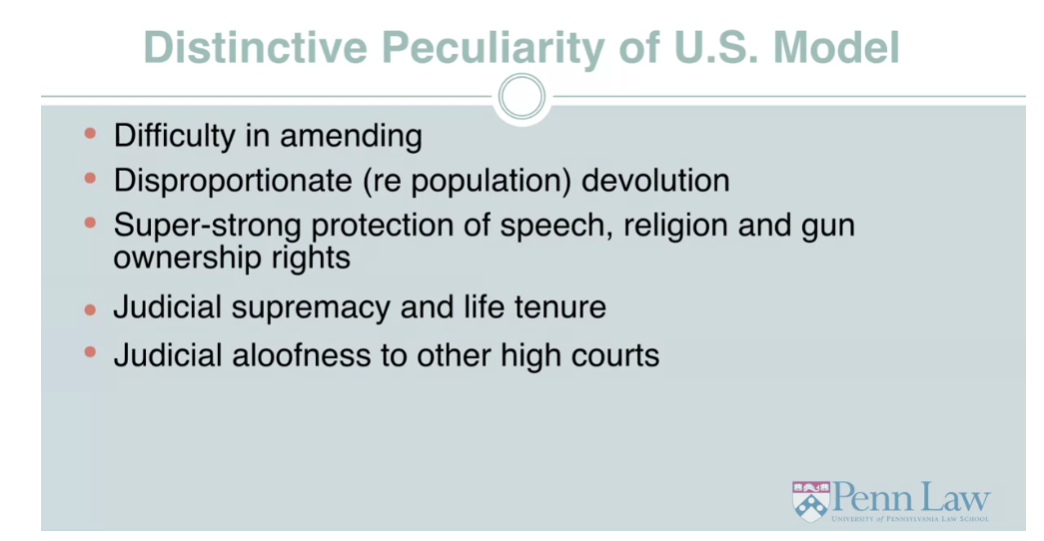
At least not Supreme Court judges. Most other countries Supreme Courts
have judges sit for eight years or ten years or even 15 years. But they’re unwilling to say
that a judge gets his or her seat, as long as they keep
drawing breath on this Earth. And, many scholars, even of the US Supreme
Court, looking at the super long tenure. Sometimes more than 30 or 35 years of
some American Supreme Court justices. Have said that this may be, a part of our Constitution that
we might reconsider if we could. Now of course it’s so difficult
to amend I don’t anticipate that. Perhaps because of the age of the U.S.
Supreme Court and the age of the U.S. Constitution,
our Supreme Court is still very shy and very reluctant to support other, support
and cite, other Supreme courts around the world, considering similar
structural or individual rights cases. Many other high courts
look to their neighbors or look around the world to colleagues and
attempt to get some judicial guidance. Many justices on the U.S. Supreme Court
have asserted fairly categorically, that that kind of judicial
looking around is, is impermissible, and we’re,
in that sense they’re somewhat unique.
Perhaps even more importantly for
the lives of individual citizens, although the U.S. protects lots of individual
rights against government action, what we might call negative rights,
or negative liberties. The ability to say say to the government
you may not throw me in jail for giving this speech. You may not throw me in jail for making
these sexual or reproductive choices. Those are called negative liberties. The U.S. Constitution by and large does
not protect positive entitlements, positive freedoms:
the right to health care, the right to housing,
the right to education.
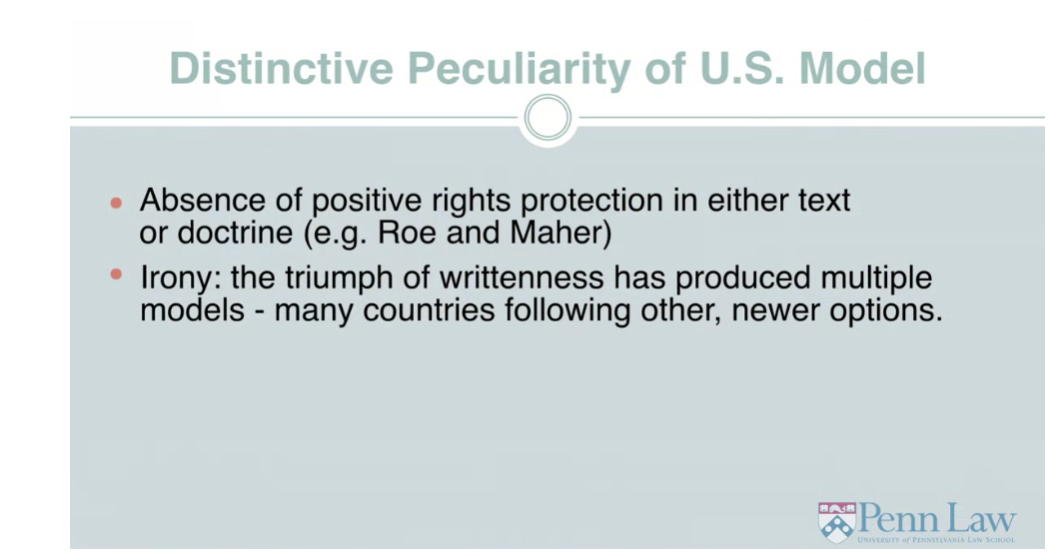
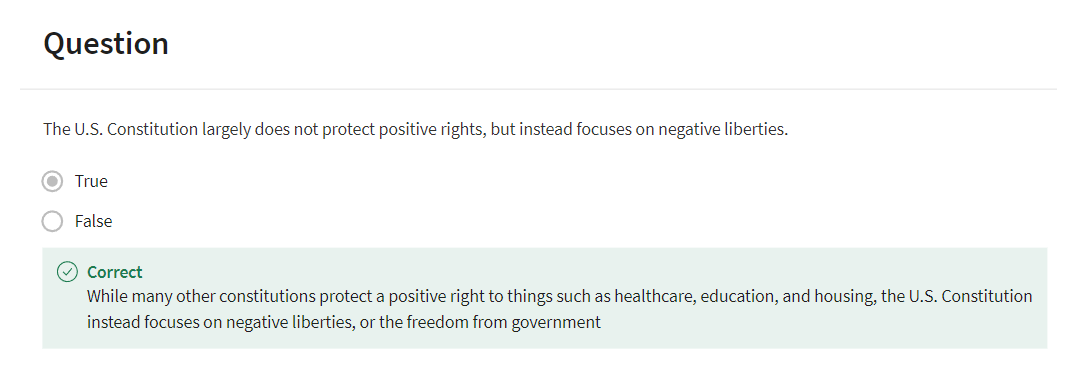
And many other national constitutions do,
so the U.S. is an outlier in the strong dichotomy
that it draws in its constitution, and the court’s interpretation between
negative liberties against government tyranny and affirmative
rights to inputs into one’s good life. This is vividly explained in
the abortion cases where famously Roe v Wade gives a certain limited
right to women to choose to have an abortion at certain
periods of the pregnancy. But in other case, less well known
Maher v Roe says quite clearly a poor woman can’t access government
funding to effectuate the abortion right. So there’s an, there’s a right to say to,
to say no to government intrusion. There’s no right in the U.S. context, to government financial
support for that decision. And many countries would find
that dichotomy very incongruous, to give a right, but not to give
the financial means to effectuate it.
As all of this shows the U.S. Constitution is tremendously
influential around the world. But, its influence was more in generating
this culture of written constitutionalism. Rather than in specifying the exact
content of the new constitutions that have emerged in most countries
over the last half century. And here there’s a certain irony, is the
very fact that the U.S. Constitution was so important and so old, kind of made it
like an original model of a vehicle or something, where newer designers have
taken things in very different directions. So, this boast confirms the influence
of the U.S. Constitution in our world. But also shows that there are other
choices that other nations have made that we might consider even in our own
constitutional order about whether there are, there are better design features
that we might think about going forward.
I’ll conclude in the way I started,
namely by focusing on the, the greatest founding father of
the Constitution, James Madison. Madison said,
What is government itself but the greatest of all
reflections on human nature?
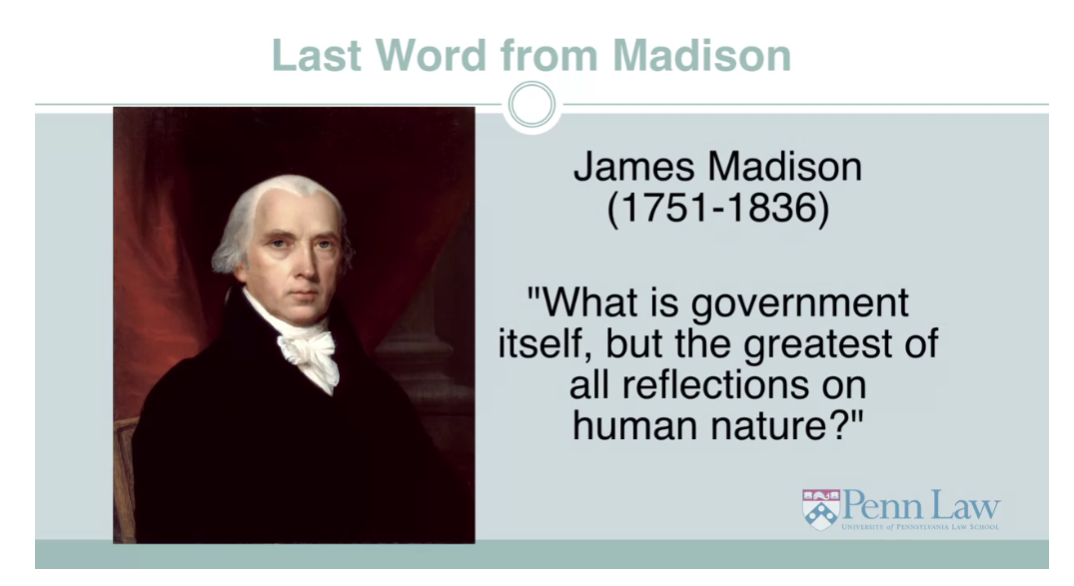
And this fits with several themes I’ve
tried to bring out in this segment. Over 200 years ago Madison and his colleagues met in Philadelphia
a few miles from where I stand here. To produce a canonical text that’s
remarkable in its innovation, remarkable in its brevity. And remarkable in the number of subjects
it tried to cover in relatively few words. But the framers, as evidenced by Madison’s
quote here, weren’t disconnected from the realities of we the people, a phrase
they put right there in the constitution. They realized that this text they wrote
was not going to interpret itself, it doesn’t give easy answers to
the questions that it raises. It doesn’t contain definitions,
it doesn’t contain a detailed users guide.
And the constitutional law, and
constitutional culture that we have today, reflects the text that they worked
on two centuries ago, but it also reflects the intervening generations and
most importantly, the present generations interpretation and life and values
that we infuse with the Constitution. The Constitution is not living,
but we are, and that’s an imperative that ought
to guide our interpretation. Thank you. [MUSIC]
Constitutional Law Quiz
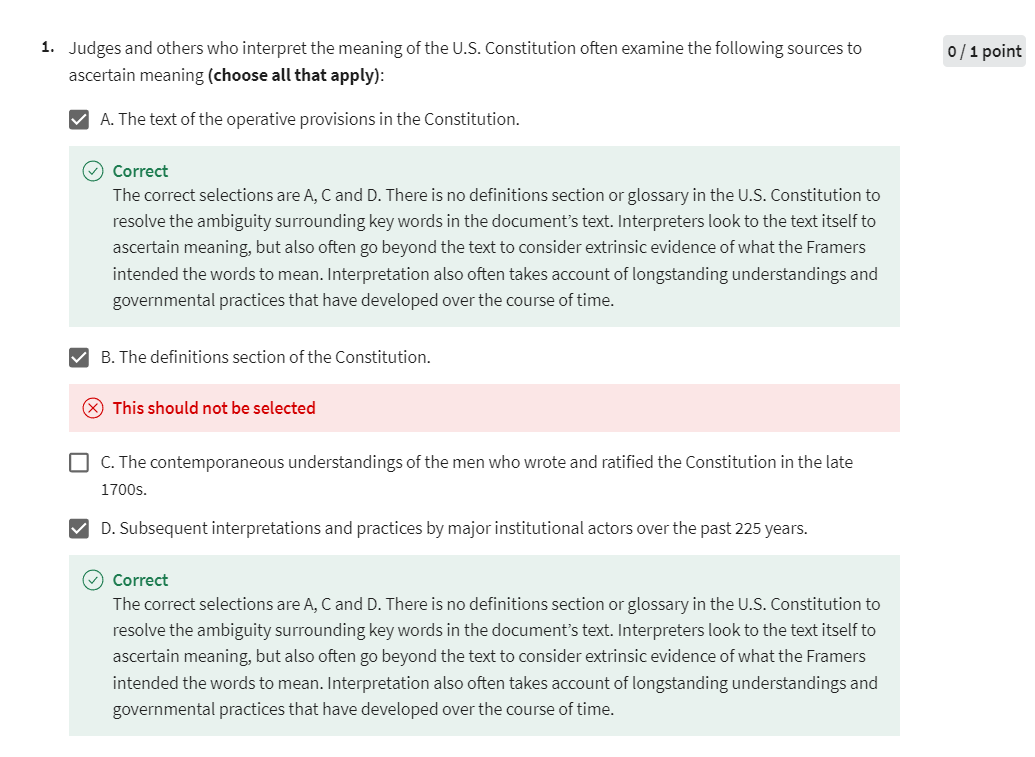
第一题更正后:

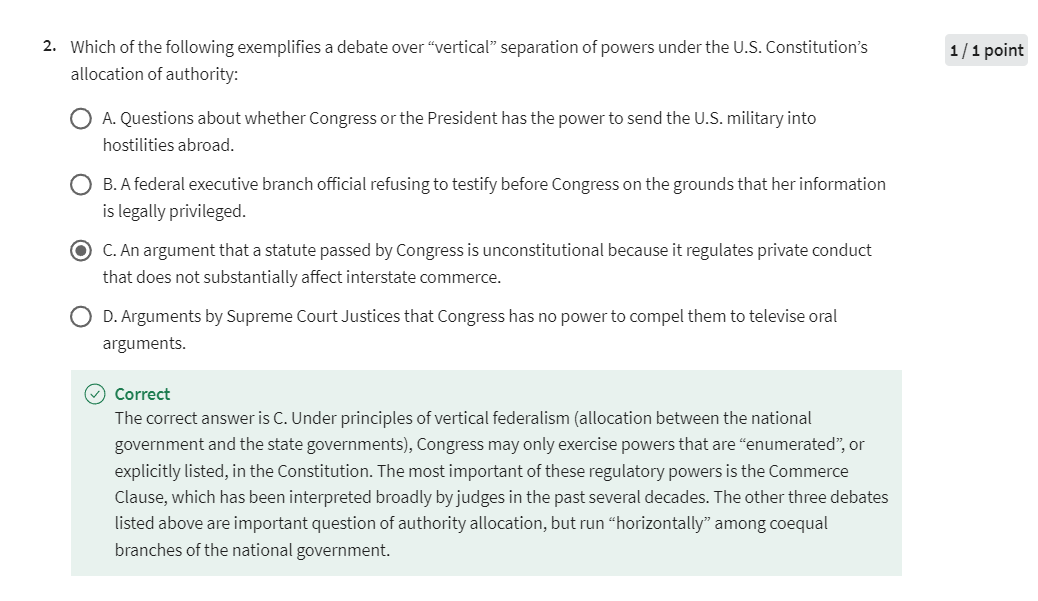
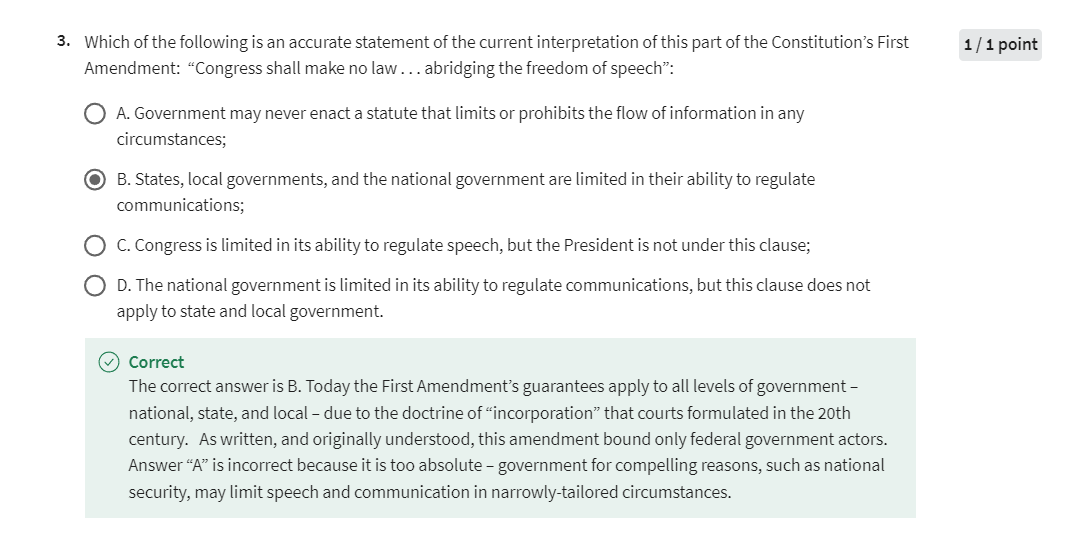

法律英语
frame:制订
constitution was framed :宪法被制订
the obligation to base decisions on the Constitution as opposed to the law was peculiar to the American judge 根据宪法而不是法律作出判决的义务是美国法官特有的
constitutionalism:英 [kɒnstɪˈtjuːʃ(ə)n(ə)lɪz(ə)m] 立宪政体;拥护立宪政体
Articles of Confederation: 联邦条例
《邦联条例》(Articles of Confederation)是美国建国初期颁布的一部文件,于1777年通过,至1781年生效。这个文件确立了美国第一部联邦政府的结构和权力范围。《邦联条例》将权力下放给各州政府,而中央政府的权力相对较弱,只具有一些有限的权力,如宣战和签订条约。然而,由于中央政府的权力过于有限,导致各州之间的矛盾和问题增多,因此在1789年《美国宪法》生效后,取代了《邦联条例》,建立了更强大的中央政府。
The Articles of Confederation were the first constitution of the United States, adopted in 1777 and ratified in 1781. They established a weak central government with most powers delegated to the individual states. The central government had limited authority, such as declaring war and making treaties. However, due to its limited powers, the Articles of Confederation led to various conflicts and issues among the states. Eventually, they were replaced by the U.S. Constitution in 1789, which established a stronger central government.
oblige:美 [əˈblaɪdʒ] 迫使,强迫

provision:美 [prəˈvɪʒn] 条文,条款
revise:更正,修订
executive power:行政权
be vested in:授予,归属,赋予
the executive Power should be vested in President. 行政权应该授予总统。
bail:保释
expound:美 [ɪkˈspaʊnd]详述,阐释,解释,说明
judicial:美 [dʒuˈdɪʃl] 司法的,法院的
explusion:美 [ɪkˈspəlʃən] 开除,驱逐
tribe:美 [traɪb] 部落,宗族
This case, arising in 1832, involved a review of the state of Georgia’s forced expulsion of the Cherokee Indian tribe. 该案发生于1832年,涉及对佐治亚州强制驱逐切罗基印第安部落的复审。
monarch:美 [ˈmɑːnərk] 君主,国王,皇帝,女王
allude to:提到
he acknowledged a basic challenge which I’ve alluded to before 他承认了一个我之前提到过的基本挑战
prerogative:美 [prəˈrɑɡədɪv] 特权;独有的权力;特性;
national government prerogatives:国家政府特权
wrangle:美 [ˈræŋɡəl] 争吵,争辩,争论
sphere:英 [sfɪə] 范围,领域
cooperate or conflict or wrangle over the proper sphere of authority. 在适当的权力范围内合作、冲突或争吵。
commerce clause:商务条款;商业条款;贸易条款
dormant: 美 [ˈdɔːrmənt] 冬眠的;在深睡的;休眠的;静止的
Dormant Commerce Clause:惰性商业条款
The Dormant Commerce Clause, also known as the negative Commerce Clause, is a legal doctrine that stems from the Commerce Clause of the United States Constitution. While the Commerce Clause explicitly grants Congress the power to regulate interstate commerce, the Dormant Commerce Clause refers to the implicit limitation it places on states’ ability to regulate interstate commerce.
Under the Dormant Commerce Clause, states are prohibited from passing legislation that unduly burdens or discriminates against interstate commerce, even in the absence of federal regulation. This means that states cannot enact laws that favor in-state economic interests over out-of-state interests or create barriers to the free flow of commerce across state lines.
The Dormant Commerce Clause is based on the principle that the regulation of interstate commerce should be uniform and consistent across all states, preventing economic protectionism and promoting a national economy. It is primarily enforced through judicial review, with courts striking down state laws that violate the Dormant Commerce Clause.
惰性商业条款,又称消极商业条款,是源自美国宪法《商业条款》的法律原则。虽然《商业条款》明确授予国会对跨州商业进行监管的权力,但惰性商业条款是指对州政府在监管跨州商业方面的隐含限制。
根据惰性商业条款,州政府被禁止通过对跨州商业构成不合理负担或歧视性的立法,即使在没有联邦监管的情况下也是如此。这意味着州政府不能颁布偏向本州经济利益而损害跨州利益的法律,也不能设立跨州商业自由流动的障碍。
惰性商业条款基于一个原则,即对跨州商业的监管应该在所有州之间是统一和一致的,以防止经济保护主义并促进国家经济。它主要通过司法审查来执行,法院会废除违反惰性商业条款的州法律。
the doctrine of enumerated powers: 列举权
The doctrine of enumerated powers refers to a fundamental principle in the United States Constitution that delineates the scope of the federal government’s authority. According to this principle, the federal government possesses only those powers explicitly enumerated in the Constitution, rather than any other unspecified powers. If a power is not specifically listed in the Constitution, the federal government lacks the authority to exercise it, and such powers are reserved to the states or the people.
The principle of enumerated powers reflects the system of federalism in the U.S. Constitution, aiming to limit the federal government’s authority and prevent its overreach. It ensures that the federal government operates within the boundaries set forth by the Constitution, with other powers reserved for the states or the people.
The principle of enumerated powers is explicitly stated in the Tenth Amendment to the U.S. Constitution, which asserts that powers not delegated to the federal government are reserved for the states or the people. This principle holds significant importance in the U.S. legal and political system, influencing the allocation and exercise of powers between the federal government and state governments.
列举权原则是美国宪法中的一个重要原则,它规定了联邦政府的权力范围。根据这个原则,联邦政府只能行使宪法中明确列举的权力,而不是其他未列举的权力。如果某项权力没有在宪法中列举,联邦政府就不具有行使这项权力的权利,而这些权力则归属于各州或人民。
列举权原则反映了美国宪法的分权制度,旨在限制联邦政府的权力,防止其过度扩张。它确保了联邦政府只能在宪法授予的范围内行使权力,而其他权力则保留给各州或人民。
列举权原则在美国宪法的第十修正案中得到了明确体现,该修正案规定未列举的权力归属于各州或人民。这一原则在美国法律和政治体系中具有重要地位,影响着联邦政府和各州政府之间的权力分配和行使。
statutory:美 [ˈstætʃətɔːri] 成文法的;法定的;依照法令的;
enactments:美 [enˈæktmənts] 法律;法规;颁布;
major statutory enactments:主要法规
anti trust laws:反托拉斯法
Antitrust laws refer to a set of regulations aimed at preventing monopolies and promoting competition within markets. These laws are designed to ensure the presence of multiple competitors in the market, preventing any single company or organization from monopolizing and thereby harming consumer interests. Antitrust laws typically include provisions that prohibit monopolistic behavior, price fixing, price discrimination, and other actions that undermine competition. Enforcement of these laws is typically carried out by antitrust departments or commissions tasked with overseeing markets and taking action to preserve competitive environments.
反托拉斯法是一系列旨在防止垄断和促进竞争的法律。这些法律旨在确保市场上有多个竞争对手,防止某一家公司或组织垄断市场,从而损害消费者利益。反托拉斯法通常包括禁止垄断行为、价格操纵、价格歧视以及其他损害竞争的行为。这些法律的执行机构通常是反托拉斯部门或委员会,负责监督市场并采取行动来保护竞争环境。
outcry: 强烈抗议;喊叫,呐喊
child labor:童工
Affordable Care Act :平价医疗法案
Affordable Care Act case of 2012指的是美国最高法院于2012年审理并做出裁决的一起案件,即《平价医疗法案》(Affordable Care Act)的案件。这个案件的核心是关于《平价医疗法案》中一项具有争议性的条款,即个人保险责任条款(individual mandate),该条款要求大多数美国公民购买医疗保险。法院最终裁定该个人保险责任条款是合法的,这是因为它被认为是根据美国宪法中的税收权力而实施的,而不是根据美国宪法中的商业条款。这一裁决对美国的医疗保健政策和法律产生了深远的影响。
mandate:授权,委托,命令
individual mandate:个人保险责任(individual mandate)是《平价医疗法案》(Affordable Care Act)中的一项政策措施,要求大多数美国公民必须购买符合标准的医疗保险,否则将面临罚款。该政策的目的是通过增加健康保险的参与者数量,从而降低医疗保健成本,提高保险计划的可负担性,并促进整个医疗系统的可持续性。
situate:美 [ˈsɪtʃueɪt] 使xxx位于,建于,置于环境中
jurisprudence:美 [ˌdʒʊrəˈsprudns] 法学,法律体系
situate the individual rights jurisprudence of the American Constitutional order within the longer textual and historical tradition:将美国宪法秩序中的个人权利法理学置于更长的文本和历史传统中
incorporation:合并,公司
denomination:面值,命名,分类,基督教教派
construe:美 [kənˈstru] 解释,说明,诠释
construing the Constitution:解释宪法
petition:美 [pəˈtɪʃn] 向xxx请愿,诉求,正式请求,要求
redress:补救,补偿,矫正
grievance:美 [ˈɡriːvəns] 委屈,冤情,不满,投诉
petition the government for a redress of grievances 向政府请愿申冤
operationalize:实施,运作
What is needed is a more thick institutional culture of enforcement and acceptance, to operationalize those words我们需要的是一种更浓厚的执行和接受的机构文化,以落实这些话
pledge:美 [pledʒ] 保证,承诺,誓言,宣言
commitment:投入,承诺
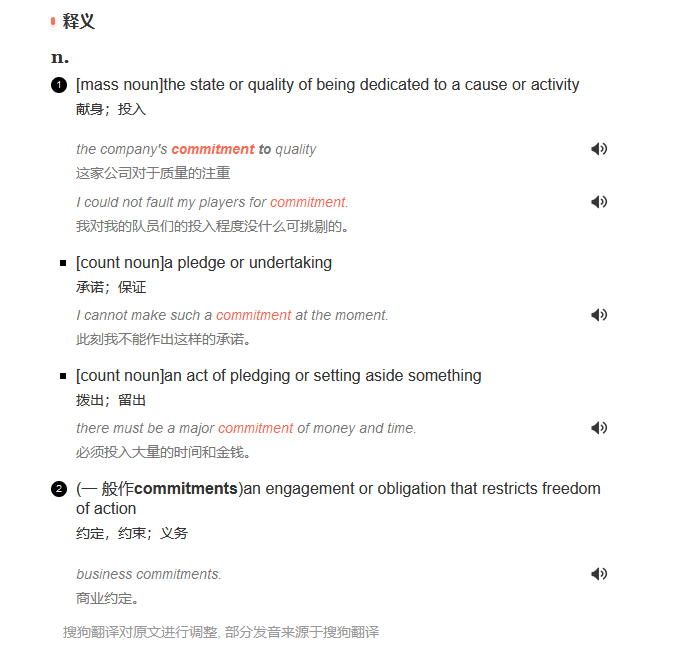
That requires an ongoing and evolving societal commitment. 这需要持续和不断发展的社会投入
a wide swath of: 一大片
scrutiny:美 [ˈskruːtəni] 仔细观察,详细审查
comply with First Amendment scrutiny 遵守第一修正案审查
transpress:违犯,违背
local police enforcement could transgress religious freedoms protection 当地警方的执法可能会违背宗教自由保护
adversely affected: 受到不利影响的
The way the court strikes this balance depends, in his words, on the constitutional and societal importance of the interest adversely affected 用他的话说,法院实现这种平衡的方式取决于受到不利影响的利益在宪法和社会中的重要性
sporadic:美 [spəˈrædɪk] 零星的,零散的
This in turn means the U.S. Constitution is largely frozen as it’s written with only sporadic episodes of amendment over the past 200 years. 这反过来意味着美国宪法在很大程度上处于冻结状态,因为在过去200年里,美国宪法只进行了零星的修订。
disproportionate:不相称的;不匀称的,不成比例的
tenure:美 [ˈtenjər] 任职,终身职位,任期
give judges life tenure:赋予法官终身任期
dichotomy:美 [daɪˈkɑːtəmi] 区分,区别,二分法
incongruous:美 [ˌɪnˈkɑŋɡruəs] 不协调的,不一致的
effectuate:使生效;实行;实施
And many countries would find that dichotomy very incongruous, to give a right, but not to give the financial means to effectuate it 许多国家会发现这种二分法非常不协调,给予权利,却不给予实现权利的财政手段
后记
2024年4月26日13点56分开始学习 Week 4:美国宪法。截至2024年4月27日16点36分,完成Week 4的学习。总共花费3.5小时。
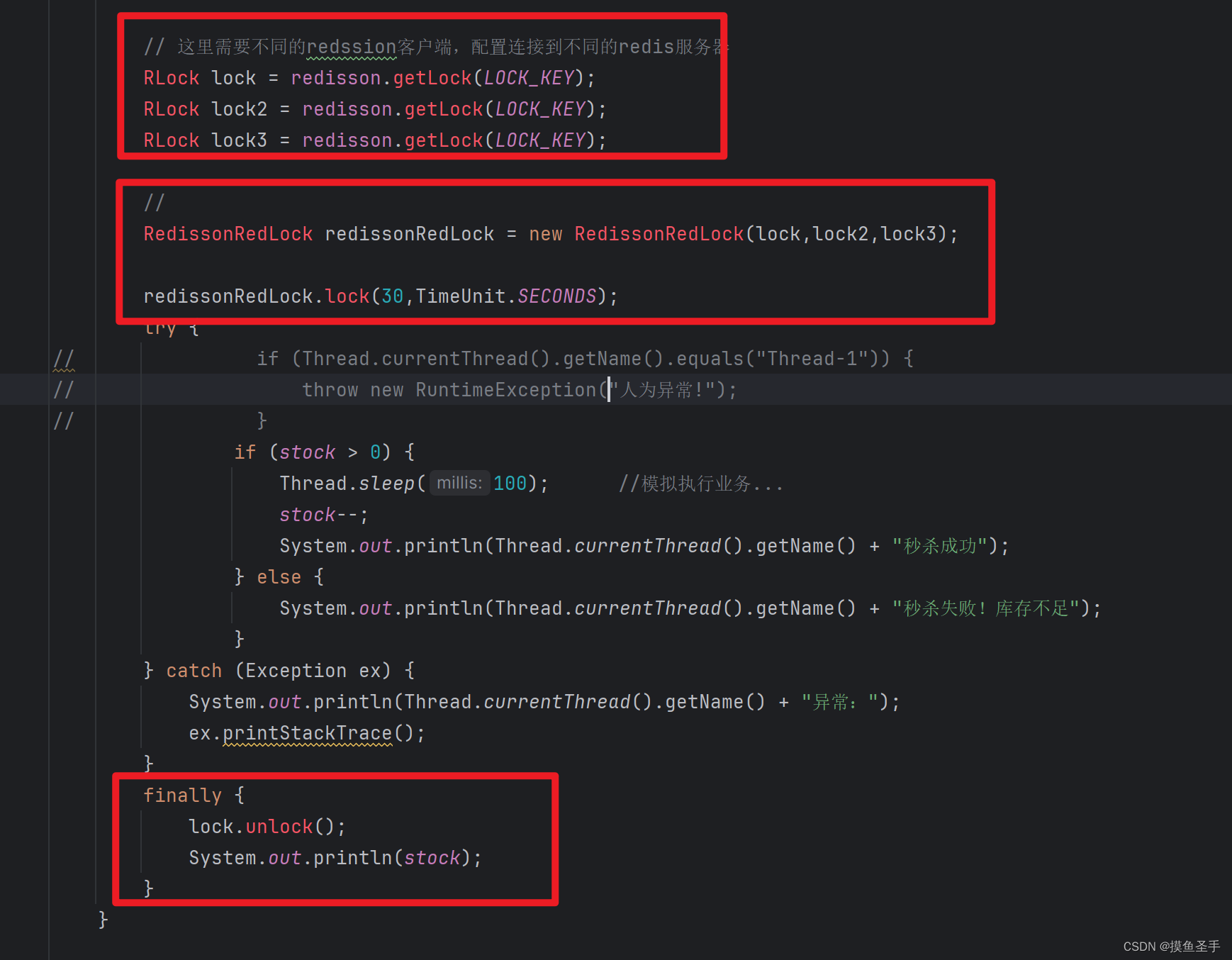



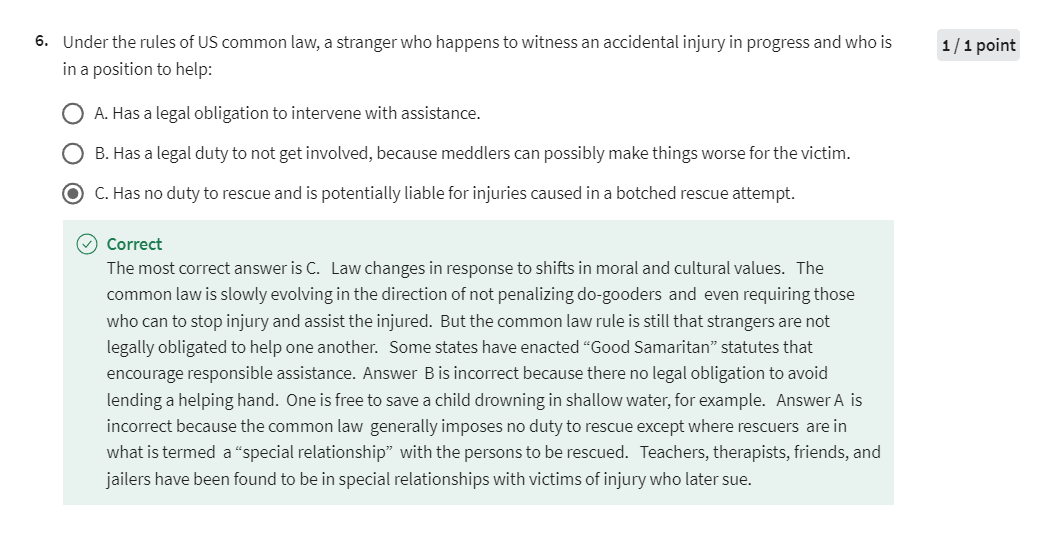

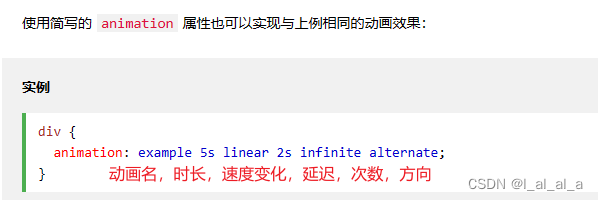


![微信小程序[黑马笔记]](https://img-blog.csdnimg.cn/direct/9bffbb8c50b34f4bbe8e70db8ff5fa5a.png#pic_center)

